#with an arc that your character(s) need to experience to learn an element (for characters who have yet to understand the pure
Text
you know im starting to think that all this mulling over the disparity and intersectionality inheret to yin and yang and the four elements is less of a hobby funtime hyperfixation and more like a. im discovering the source of my ideology and spirituality
#talk#recently ive been realizing that playing with the different combinations of#active yin and yang (the self. action. by the means of. water and fire)#and passive yin and yang (the world. perception. for the purpose of. earth and air)#and the different paths that a person can take on their journey to reach understanding of all four elements#is a fantastic way to imagine up three dimensional characters. locations. histories. cultures. arcs. stories.#even after achieving all four elements; how do the elements that a character began with that most identify that character?#which elements does a person have? which elements are they missing? how does this create conflict?#line up the elements of a locale (a vast night city. practically unknowable via all its small pieces but easily perceptible as a whole.#THE WORLD. the earth is the foundation of the city. buildings. networks. infrastructure. the air is the freedom of the city.#people doing as they please. gusts of wind blowing on rooftops. lights beaming and flickering separately but as a whole)#with an arc that your character(s) need to experience to learn an element (for characters who have yet to understand the pure#vastness of the world [no earth or air]. for characters who love the freedom but cant stand the form that its built on [only air].#for characters who are familiar with the infrastructure but dont know how to set themselves loose into what it offers [only earth].#and then characters who are equipped to embrace the city in full and offer guidance to the other characters when prompted [earth and air])#ive been setting my mind LOOSE in it and the ONLY thing that i get is interesting and dynamic and real ideas.#it is an absolute story building gold mine and it is by design that its a gold mine
2 notes
·
View notes
Note
Please explain how you can like b*ruto while criticizing it at the same time we're confused. And then you write about adult nar/sas/ even though they've done the worst. How can you say that era is so great? Just tryna understand here. Usually I get your logic but not this. Also when you think it s done?
Hi Non.e, when did I say that?

I said, I felt like 'Boruto' as a show had a lot of potential. And what I mean with that is that I feel like Kishimoto was definitely on to something with the movie when it comes to a major storytelling element which is 'Theme'. But also the change the world itself had undergone when it comes to technology. How incredibly frustrating it must be how these gremlins suddenly lack the motivation to train because they can simply get every Jutsu they need in a damn mini-scroll anyway. People don't even need any Chakra anymore. It's like people skip the process to get to an end-result as fast as possible. Does it sound familiar??????
That's huge!!
And for some reason these kids learn Jutsu fast as hell.


The kid learns a damn Rasengan immediately. Like in what, 2 days?
This dystopian, cyberpunk'ish-type of vibe has so much potential for so many interesting arcs despite the bitter edge it gives.
But like.. the writers don't even give a damn it seems like. It's almost as if Kishimoto wants to take advantage of the potential but is tired of it too. When things don't go your way or when the people around you don't value the same things.. I mean, I'm just speculating.
And even if I like the SNS moments, there are parts in the movie and the beginning of 'Boruto' that I really, severely dislike too. You wouldn't hear/read me say that 'Boruto' is great in any way. I liked Sarada in Gaiden for example but she's annoying as hell in 'Boruto'. Her obsession with her father makes me uncomfortable. These kids are literally out of nowhere lecturing Sasuke... Boruto bolts after cutting Sasuke off and Sarada jumps in trying to be all sassy towards her father.
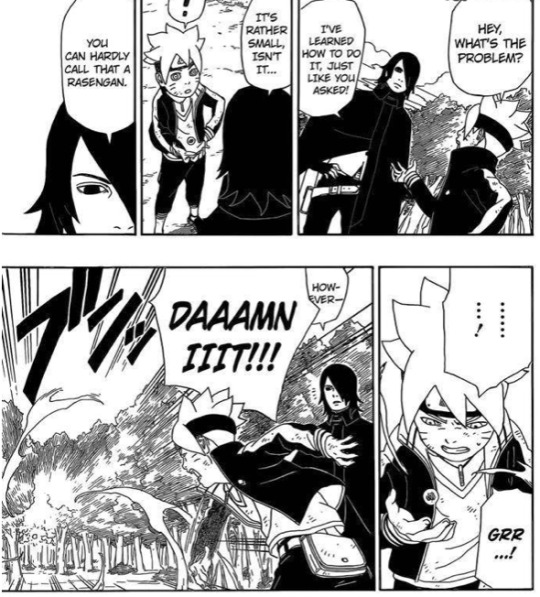
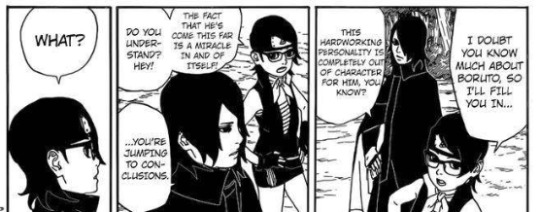
"Do YoU uNdErsTand? HeY!" They irritate me. Have some respect gdi.
Sasuke whose adult character sketches from Kishimoto looked absolutely amazing. Who is at the end of Shippuden together with Naruto one of the most powerful Shinobi and forced to get nerfed to favor an out-of-balance power-scale. One that doesn't even make sense in the slightest. Not even with technology. Whose eyes who see everything can't even see a kid with a kunai coming.
No wonder ms. experiment needs glasses. LoGic. Idc.
And it's not just that, the way they're drawn too...
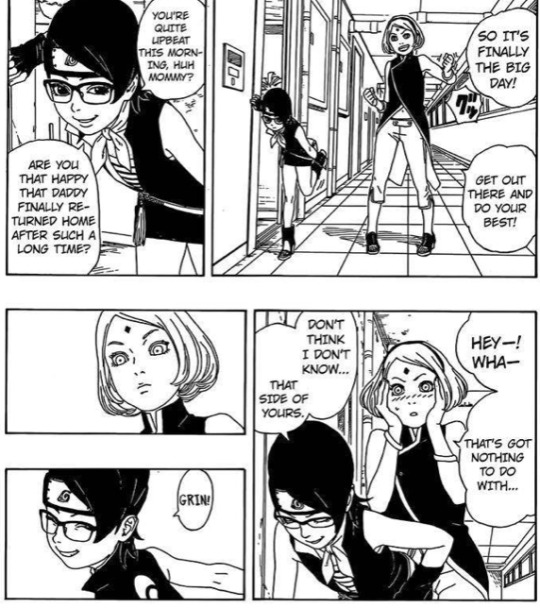
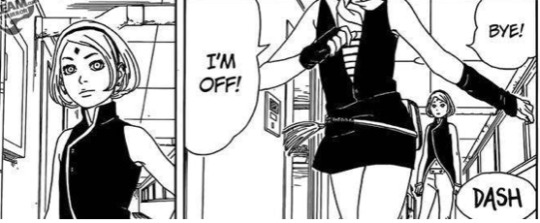
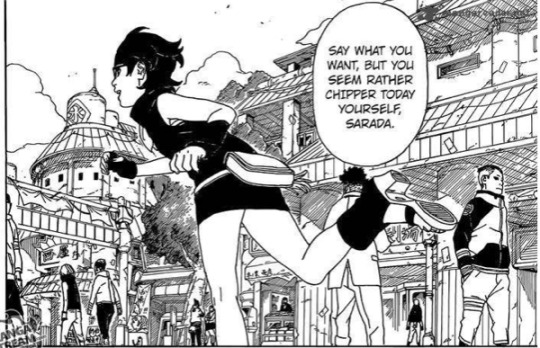
They're talking about Sasuke, yet the visual focus is so much on Sarada's bare legs in that tiny, TINY dress. Creepy as hell. BARF.
Mind you, I just took your hand briefly and showed you a few panels from just the first 2 Chapters. There are infinitely more moments that annoyed me. The writing is bad, it's visual representation is bad, I don't like these kids although Boruto's growth as a character is okay (I haven't caught up yet)- I'll say it again, you will not hear/read me say that 'Boruto' is great. Ever.
But the world and the era had potential. That's all.
31 notes
·
View notes
Text
How Do I Plan? Tag
Thank you, @elizaellwrites for the tag! Much appreciated.
How do you plot your writing?
Step 1: Beginning with the Characters
No matter how hard I try to start with a plot idea, the characters usually come first (though, this was not the case for my second novel – the plot came first, but I digress). I could be working or simply reading a story and the inspiration for my characters for my own novel(s) run through my mind. Inspiration may also strike when listening to a song, looking at art, in thinking back to my own past experiences – certain traits about them stand out to me, and automatically, I begin to construct a character based on even the simplest of details. If I can’t get it down on paper immediately, I try to make a mental note of the strongest elements that stand out to me about that character. Then I begin to develop them from there.
Step 2: Research for the Fictional World
Once I’ve created the characters, I tend to rush straight into developing the fictional world. I jot down my ideas (those that I call “cold ideas;" they're without research, only based on my initial thoughts) and determine what could work and not work for my world, for my characters. Research follows swiftly after. I go into a “research frenzy” for months at time (depending on how big my fictional world is and what I decide to put my characters through) before even putting a pen to paper. For my current fantasy series, I spent about 2-3 years researching before I began my first draft. I file all my research and return to it when needed. Even the simplest details are filed away. Once I’ve gotten a general idea of how I want my fictional world to look, I begin to look at the plot.
Step 3: Development (mixing plot, world-building, and characters together)
This is where I begin to mix plot, world-building, and my characters. Always, I ask “What if…?” about a particular theme/issue that I want to address within my plot, and I go from there when working on the plot. I ask the same question of my characters, when fitting the plot around them. If something in the plot doesn’t fit with how I perceive the characters, then I make changes (either to the character or to the plot itself). I also consider how the world I’ve created will affect the plot. I only spend a few weeks to a few months here at a time, creating a rough map of how I want things to go.
Step 4: Outlining
I’ve always hated outlining, but I find that it’s extremely useful, even if writing a short story. I tend to outline in detail, as I like to get all my thoughts out on paper about how a character arc will progress, how the plot will progress, how each affects others in the story. Then I go back and tweak it as I see fit. Of course, outlining doesn’t mean I’m not open to surprises; I am. They generally come, of course, in the writing process itself.
Step 5: Writing
After going back over my notes for weeks to months, I then sit down to write. Surprises, as stated earlier, can happen here. Rewrites happen in increments – if I’m not satisfied with a current chapter in my novel (even if I’m in the first draft phase), I go back and I rewrite it again. The refining and editing process can take a while, so I’ve learned to be patient with myself and remind myself that not everything is going to be perfect on the first – or even second and third – attempt.
What is your favorite part of the writing process?
I have two favorite parts – Constructing my characters/my world, and the writing process itself. With constructing characters, I love seeing how each come together and compliment (or not) one another. I love determining their dynamics, their personalities, their quirks, histories, relationships…you name it. I love making them feel more human, more relatable to my audience. I love seeing how they grow and how they progress over the course of the novel(s), how they mature and change.
In the writing process, I can finally see how everything comes together. I can see where there are plot holes (if I didn’t see them earlier), I can finally see, in written form, how each character interacts with one another or with their environment. I adore seeing if the world I’ve created takes precedence or takes more of a background role (in my books, I’m finding it does more of the latter, but is still…present). I love seeing when the draft (even if it’s the first) is done, and I’m holding a physical copy of it in my hands. Just knowing that a draft is complete is so rewarding.
0 notes
Text
Why did you write two versions of Hunger Pangs?
What’s the difference and is one more “valid” than the other?
I get a lot of questions when people find out I wrote two versions of Hunger Pangs (Phangs). To answer that second question first, the only difference is that one contains explicit sexual content, and the other merely alludes to it.
The Flirting with Fangs edition (red cover) contains multiple scenes that depict sexual acts, either solo or partnered. (link)
The Fluff and Fangs edition (blue cover) is less explicit. I say less because while the scene(s) fade to black, some elements of physical affection are still shown, along with a fairly involved conversation about consent and kink. This is in the latter half of Chapter 28, and as noted on my website, you can skip this part if it makes you uncomfortable and not miss anything important to either the plot or character development. (link)
Both versions contain heat ratings and content warnings on my website. I can’t put it in/on the books themselves because Amazon is going after authors for mentioning content warnings (link), so when in doubt, check www.joydemorra.com or send me a message!
And no, one version is not more “valid” than the other. Both are canon. If it helps, think of them as parallel universes running side by side down the narrative timeline. The plot and character development remain the same; the scenes have just been altered to accommodate reader preference.
Then why do this at all?
As stated above, I wrote two different versions primarily to accommodate reader preference. When I first started writing Hunger Pangs: TLB, I was widely known on Tumblr for being “that erotica editor.” (link) I used to be a ghostwriter for my publishing house, too, so chances are some of you have already read my work under another author’s name*. A large chunk of my professional life has been spent writing sexually explicit content. It’s what I was then known and popular for, so it never occurred to me that anyone who was sex averse or didn’t enjoy reading about sex would be interested in my work.
And then those exact people started messaging me to let me know they were super excited about my work, couldn’t wait to buy a copy and would just skip past the sex parts that made them uncomfortable.
And that didn’t sit right with me.
Phangs is a bit of a weird project. It was started via a Tumblr shitpost (link) and grew from there. It was funded entirely by the support of my Patreon, which people kept supporting even after it took me years longer to finish it than initially planned because my health took a proverbial nose dive into the tenth circle of hell. It is not an exaggeration to say my Patreon and Tumblr kept me alive during that time. You kept our lights on and put what little food I could eat into my fridge. You supported me both physically and emotionally during one of the worst times of my life. And during that time, I wrote the entire Phangs series, assuming it would be edited and published posthumously**. It was both my swan song and a parting gift. A means of saying thank you for all your support over the years and the fervent hope you’d feel my love on every page. Because never doubt this, I wrote Phangs for you. Phangs is a love letter to fandom from start to finish. It’s written specifically to appeal to fandom and all the things we love about it.
So when people told me they were going to buy it but skip parts of it, I felt the need to make sure they were getting equal amounts of content for their money. So the “fluff” version of the narrative was born, replacing the sex-based scenes with more emotional and “fluffy” but still intimate interactions that keep the character arcs and plot intact.
For the first book, I tried to keep the scenes as similar in theme as possible. That’s why Chapter 28 still features a frank discussion around kink and consent, as a large part of Vlad’s character arc is learning that his wants and desires matter, but more importantly, so do his boundaries. But I also purposefully wrote it so that you can skip away after that conversation and not miss anything in the lead-up to the fade to black/implied sex scene. As the series progresses, the scenes may differ more as I play around having fun with it. But the fact remains that the characterization and plot will always stay true.
It’s merely about what kind of reading experience you want.
Do I expect other authors to do this? Absolutely not. This is a labor of love. The “fluff” version being popular is merely a bonus that enables me to keep writing. So thank you. I’m off to keep working on the next story.
*Before anyone asks, no, I can’t tell you who. I signed NDAs that are still in effect.
**Jokes on me, I guess because I lived, and now I have to edit and rewrite all 500-f*cking-k of it.
3K notes
·
View notes
Text
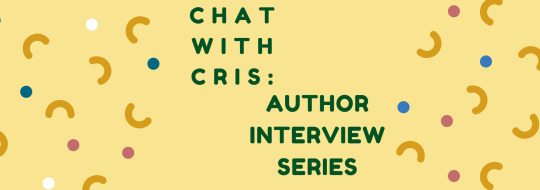
INTERVIEW NO. 1: RACHEL @djarinsbeskar
hello hello! i am so happy to announce that rachel — aka the immense talent that is @djarinsbeskar — has agreed to be my first interviewee for this new series! thank you to rach and to each one of you for all of your support. to read more about the project, click here, and to submit an author, click here.
| why rachel? |
Rachel captured my imagination from the first time we interacted as mutuals-in-law. She’s bursting with energy and vivaciousness, with a current of kindness just underneath everything she does. Her work is no exception. Oftentimes gritty, raw, and exposing (in … ahem…more ways than one), Rachel challenges her readers to dig deeper into both the story and themselves. Her smut brings a particular fire as it’s laced with need, desire, and mutual trust that leads us deeper into the characters’ identities and how physical affection can mimic other forms of intimacy. She’s a tour de force in this fandom and an absolute joy.
| known for |
Engaging with and encouraging other authors, cultivating inspo posts, attention to world building & character development
| my favorites |
Stitches
Boxer!Din
Full Masterlist • Ko-Fi
| q & a |
When did you start writing? What was that project, and what was it like? Has that feeling or process ever changed over time? Why?
I can’t remember a time I wasn’t writing. I was an avid reader, as I think most writers are—and I remember, after picking up Lord of the Rings—that I could live so many lives, experience so many things, all from the pages of a book. I could make sense of the world through words and ink and paper. And it offered me a level of peace and clarity I wanted to share with others. So, I started writing.
My first project I remember to this day, was a short story about a dog. I had been so heartbroken when I learned that dogs were colourblind. I must have been about seven or eight at the time, and I was fixated on this idea that dogs couldn’t see the vibrant hues that made the world beautiful. It was something I wanted to change—and with all the righteous anger of a child not getting their own way, I sulked over the fact that I couldn’t. Until I wrote it down.
“How do dogs see colour?”
And much like my writing today, I answered myself.
“Dogs don’t need to see colour. Dogs smell colour.”
And so, I wrote a story, about a puppy being brought on different walks by its owner. And with every new street it walked down—colour bloomed with scent. Colours more beautiful and vibrant than we could ever hope to see with our eyes. And it gave me solace and helped me work through an emotion that – granted was immature and inconsequential – had affected me. To this day, I still smile seeing dogs sniffing at everything they pass on their walks. Smelling colour. It gave me the key to my favourite thing in life. I don’t think my process has changed much since then. Much of what I write is based on a skeleton plan, but I leave room for characters to speak and feel as they need to. I like to know the starting point and destination of a chapter—but how they get there, that still falls to instinct. I think I’ve found a happy medium of strict planning and winging it that suits me now—and hopefully it will continue to improve over time!
When did you start posting your writing, and on what platform? What gave you the push to do that?
I mean, fanfiction has always been part of my life. I think anyone who was growing up in the late 2000’s and early 2010’s found their way to fanfiction.net at some time or other. The wild west compared to what we have now! My first post was for the Lord of the Rings fandom on fanfiction.net. It was an anthology of the story told through the eyes of the steeds. Bill the Pony, Shadowfax—it was all very innocent. That was probably in 2010 when I was fifteen. I had been wanting to share writing for a long time but was worried about how it would be received. I didn’t really have a gauge on my level or my creativity and – one of the many flaws of someone with crippling perfectionism – I only ever wanted to provide perfection. That was a major inhibitor when I was younger. By wanting it to be perfect, I never posted anything. Until that stupidly cute LOTR fic. It was freeing to write something that no one but me had any interest in, because if I was writing for myself then there was no one to disappoint, right? And that was all it took. I had some pauses over the years between college and life and such, but I’ve never lost that mindset when it comes to posting.
What your favorite work of yours that you have ever written? Why is it your favorite? What is more important to you when considering your own stories for your own enjoyment — characters? fandom? spice? emotional development? the work you’ve put into it? Is that different than what you enjoy reading most in other people’s fics?
I don’t think it’ll come as much of a surprise when I say Stitches. While not original, I mean—it follows the plot of the Mandalorian quite diligently, it is the piece of work I really hold very close to my heart. Din Djarin as a character is what got me back into writing after what must have been five years? He inspired something. His manner, his personality—he resonated with me as a person in a way I hadn’t felt in a long time. And gave me back a creative outlet I had been missing.
It’s funny to say out loud—but I wanted to give him something? I spent so long thinking about his character that half my brain felt like it belonged to him—how he reacted and responded to things etc. and of course, like every dreamy Pisces—I wanted to give him love and happiness. So, Stitches came along. Personally, when writing—it’s a combination of characters, emotional development and spice (I can’t help myself) and when we can follow that development. With Stitches, it’s definitely the spice that is the conduit for development—but I adore showing how the physical can help people who struggle to communicate emotions too complex for words.
I don’t usually read for Din, as most people know—but I do enjoy reading the type of work that Stitches is. Human, damaged—but still with an undercurrent of hope that makes me think of children’s books.
You said, “much like writing today, I answered myself.” Could you talk about that in relation to Stitches?
So, I’m endlessly curious, it has to be said. Especially about why people are the way they are. Why people do A instead of B. Why X person’s immediate thought went to this place instead of that place. And I’m rarely satisfied with superficial explanations. One of the most exciting parts of writing and fanfiction especially, is making sense of that why. There can be countless explanations, some that are content with what is seen on the surface and some that go deep and some that go even deeper still.
Stitches is almost a – very long winded and much too long – answer to the questions I was so intrigued by about Din Djarin, about the Mandalorian and about the Star Wars universe as a whole. I often wondered what happened to people after the Rebellion, the normal people who fought—the people in the background. What did they do next? Did some of them suffer from PTSD? What was the galaxy like right after the Empire fell? That first season of the Mandalorian answered some of those questions, but I wanted to know more. So, I created a reader insert who was a combat medic—and through her, I let myself answer the questions of what happened next.
Regarding Din as a character, I wanted to know what a bounty hunter with a code of honour would do in certain situations—what made him tick, what made hm vulnerable. I wanted to explore the discovery of his identity. Din Djarin didn’t exist after he was taken from Aq Vetina. He became a cog in a very efficient machine of Mandalorians—and it was safe there. I wanted to see what – or who – might encourage him to step into his own. Grogu was that person in a familial sense, but what about romantically? What about individually? There’s so much to explore with this man! So many facets of personality and nuances of character that make him so gorgeous to write and think about.
Talk to me about the Din Djarin Athletic Universe. How does Din as all of these forms of athlete play off who you see him as in canon?
The Athletic Universe! How I adore my athletes. Despite being in a modern setting, I have kept the core of Din’s character in each of them (at least I hope I have!). I like to divide Din’s character into three phases when it comes to canon because he’s not as immovable as people seem to think he is. We discussed this before, how I see Din as a water element—adaptable, but strong enough that he can be as steadfast as rock. But I digress, the first phase is the character we see in the first episode. Basically, before Grogu. There’s an aggressive brutality to Din when we see him bounty hunting. He works on autopilot and isn’t swayed by sob stories or promises. He has the covert but is ultimately separate. Those soft feelings he comes to recognise when he has Grogu are dormant – not non-existent – but they haven’t been nurtured or encouraged. This is the point I extracted Boxer!Din’s personality and story from.
Cyclist!Din on the other hand—is already a father, a biological father to Grogu. And his personality, I took from that moment in the finale of Season two where I believe Din’s transformative arc of character solidified. He was always a father to Grogu, but I do believe that moment where he removes his helmet is the moment, he accepts that role fully in his heart and mind. And that is why I don’t believe for a second, that removing his helmet was him breaking his Creed. In fact, I believe it was the purest act he could do in devotion to his Creed—to his foundling, to his son. The Cyclist!AU is very much the character I see canon Din having should Grogu have stayed with him. This single dad who isn’t quite sure how he got to where he is now—but does anything and everything for his child without thought. It’s a natural instinct for him, and I like exploring those possibilities with Cyclist!Din.
You also said, “he has the covert but is ultimately separate.” What does it take for him — and you — to get to that point of being ‘not separate?’
I mentioned this above, but one of the biggest interests I have in Din as a character is his identity. He’s a Mandalorian, he’s a bounty hunter, he’s the child’s guardian but those are all what he is, not who. I think Din is separate while being part of the covert because he doesn’t know. I don’t think anyone can really be part of something if they don’t know who they are or, they struggle with their identity. It’s curious to me—how you can deceive even yourself to mimic the standard set for the many. In the boxer verse, he identifies himself in relation to his boxing—and every part of his outward personality exhibits those qualities. But when he’s given a softer touch—an outlet of affection, and comfort—we see the softer side of him surface. It’s very much the same with Stitches Din. Identity is like anything, emotions—relationships, bodies. It needs nurturing to thrive, an open door—a safe space. At least, that’s what goes through my mind when I think of him.
Who is your favorite character to read?
Frankie because there are so many ways his character can be interpreted and there are some stellar versions of him that I think of at least once a day. Javi because he reminds me of kintsugi-- golden recovery, broken pottery where the cracks are highlighted with gold. I also adore reading for Boba Fett, Paz Viszla and the clones!
Is there anything else you want your readers to know about you, your writing, or your creative process?
Hmm... only that I am quite literally a gremlin clown who is always here to chat Din, Star Wars, literature, book recs and anything else under the sun! I like to hear people's stories, their opinions etc. it helps me see things from alternative points of view and can truly help the writing process! Other than that, I think I can only thank readers for putting up with my ridiculously long chapters and rambling introspection. Thank you for indulging me always! ❤️
#pedro pascal#din djarin#the mandalorian#the mandalorian x reader#din djarin x reader#din djarin x f!reader#the mandalorian x f!reader#the mandalorian x you#din djarin x you#djarinsbeskar#chat with cris#author interview series#tuserdaniela#userastrid#usernobie#userhai#pedrostories
81 notes
·
View notes
Note
I’m just really confused as to where this idea that Zuko is gaycoded came from. Like people are allowed to have that headcanon but I don’t understand where people are coming from when they try and claim that he was undisputedly gaycoded and trying to deny it is homophobic when he’s only ever shown romantic interest in women.
I made a pretty long post on the topic a while back, but the ultimate gist of it is this: there are a lot of elements of Zuko's status as an abuse victim and trauma survivor that resonate with queer folks. This is understandable and completely fine! However, there are some parts of the fandom who have taken that to the other extreme and will now insist that those elements are uniquely queer, and that they can only be read as some sort of veiled gay/coming out narrative, even though that doesn't make much sense since there is no part of Zuko's narrative which is unique to any sort of queer experience.
I think the problem really does stem from two things being conflated--Zuko's history of abuse and trauma, and trauma&abuse being something a lot of queer people have experienced. I suspect it goes something like 'I see a lot of myself in Zuko, and I was abused for being gay, therefore Zuko must be gay too in order to have had similar experiences.' This can then lead to feeling dismissed or invalidated when other people point out that those experiences are not unique to being queer--but on the flip side, abuse victims and trauma survivors whose abuse&trauma do not stem from queerness (even if they are queer themselves) can feel invalidated and dismissed by the implication that their trauma must be connected to their queerness or it isn't valid.
This is also where the 'people don't actually know what gay coded means' part comes in, and I realize now that I didn't actually get into what gay coding (and queer coding in general) actually means, since I was so hung up on pointing out how Zuko doesn't really fit the mold. (And the few elements that exist which could be said to count are because of the 'villains historically get queer coded bc Hays Code era' thing and mostly occur in Book 1, not because of how he acts as an abuse&trauma survivor.)
Under a cut because I kind of go on a tangent about gay/queer coding, but I swear I get back to the point eventually.
Queer coding (and it is notable that, with respect to Zuko, it is almost always framed as 'he couldn't possibly be attracted to girls', rather than 'he could be attracted to boys as well as girls' in these discussions, for... no real discernible reason, but I'll get into that in a bit) is the practice of giving characters 'stereotypically queer' traits and characteristics to 'slide them under the radar' in an era where having explicitly queer characters on screen was not allowed, unless they were evil or otherwise narratively punished for their queerness. (See: the extant history of villains being queer-coded, because if they were Evil then it was ok to make them 'look gay', since the story wasn't going to be rewarding their queerness and making audiences think it was in any way OK.) This is thanks to the Motion Picture Production Code (colloquially and more popularly known as the Hays Code), which was a set of guidelines which movies coming out of any major studio had to adhere to in order to be slated for public release and lasted from the early 1930s until it was finally abandoned in the late 60s.
The Hays Code essentially existed to ensure that the content of major motion pictures would not 'lower the moral standards' of the viewing public. It didn't just have to do with queerness--cursing was heavily monitored, sex outside of marriage was not allowed to be seen as desirable or tittilating, miscegenation was not allowed (most specifically interracial relationships between black and white people), criminals had to be punished lest the audience think that it was ok to be gay and do crime, etc. Since same-sex relations fell under 'sexual perversion', they could not be shown unless the 'perversion' were punished in some way. (This is also the origin of the Bury Your Gays trope, another term that is widely misunderstood and misapplied today.) To get around this, queer coding became the practice by which movies and television could depict queer people but not really, and it also became customary to give villains this coding even more overtly, since they would get punished by the end of the film or series anyway and there was nothing to lose by making them flamboyant and racy/overly sexual/promiscuous.
Over time, this practice of making villains flamboyant, sexually aggressive, &etc became somewhat separated from its origins in queer coding, by which I mean that these traits and tropes became the go-to for villains even when the creator had no real intention of making them seem queer. This is how you generally get unintentional queer-coding--because these traits that have been given to villains for decades have roots in coding, but people tend to go right to them when it comes to creating their villains without considering where they came from.
Even after the Hays Code was abandoned, the sentiments and practices remained. Having queer characters who weren't punished by the narrative for being queer was exceptionally rare, and it really isn't until the last fifteen or so years that we've seen any pushback against that. Buffy the Vampire Slayer is famous for being one of the first shows on primetime television to feature an explicitly gay relationship on-screen, and that relationship ended in one of the most painful instances of Bury Your Gays that I have ever personally witnessed. (Something that, fourteen years later, The 100 would visually and textually reference with Lexa's death. Getting hit by a bullet intended for someone else after a night of finally getting to be happy and have sex with her s/o? It wasn't remotely subtle. I don't even like Clexa, but that was incredibly rough to witness.)
However, bringing this back to Zuko, he really doesn't fit the criteria for queer coding for a number of reasons. First of all, no one behind the scenes (mostly a bunch of cishet men) was at all intending to include queer rep in the show. This wasn't a case where they were like 'well, we really wanted to make Zuko gay, but we couldn't get that past the censors, so here are a few winks and a nudge', because it just wasn't on their radar at all. Which makes sense--it wasn't on most radars in that era of children's programming. This isn't really an indictment, it's just a fact of the time--in the mid/late 00s, no one was really thinking about putting queer characters in children's cartoons. People were barely beginning to include them in more teen- and adult-oriented television and movies. It just wasn't something that a couple of straight men, who were creating a fantasy series aimed at young kids, were going to think about.
What few instances you can point to from the series where Zuko might be considered to exhibit coding largely happen in Book 1, when he was a villain, because the writers were drawing from typically villainous traits that had historically come from queer coding villains and had since passed into common usage as villainous traits. But they weren't done with any intention of making it seem like Zuko might be attracted to boys.
And, again, what people actually point to as 'evidence' of Zuko being queer-coded--his awkwardness on his date with Jin and his confrontation with Ozai being the big ones I can think of off the top of my head--are actually just... traits that come from his history of trauma and abuse.
As I said in that old post:
making [zuko’s confrontation of ozai] about zuko being gay and rejecting ozai’s homophobia, rather than zuko learning fundamental truths about the world and about his home and about how there was something deeply wrong with his nation that needed to be fixed in order for the world to heal (and, no, ‘homophobia’ is not the answer to ‘what is wrong with the fire nation’, i’m still fucking pissed at bryke about that), misses the entire point of his character arc. this is the culmination of zuko realizing that he should never have had to earn his father’s love, because that should have been unconditional from the start. this is zuko realizing that he was not at fault for his father’s abuse--that speaking out of turn in a war meeting in no way justified fighting a duel with a child.
is that first realization (that a parent’s love should be unconditional, and if it isn’t, then that is the parent’s fault and not the child’s) something that queer kids in homophobic households/families can relate to? of course it is. but it’s also something that every other abused kid, straight kids and even queer kids who were abused for other reasons before they even knew they were anything other than cishet, can relate to as well. in that respect, it is not a uniquely queer experience, nor is it a uniquely queer story, and zuko not being attracted to girls (which is what a lot of it seems to boil down to, at the end of the day--cutting down zuko’s potential ships so that only zukka and a few far more niche ships are left standing) is not necessary to his character arc. nor does it particularly make sense.
And, regarding his date with Jin:
(and before anyone brings up his date with jin--a) he enjoyed it when she kissed him, and b) he was a traumatized, abused child going out on a first date. of course he was fucking awkward. have you ever met a teenage boy????)
Zuko is socially awkward and maladjusted because he was abused by his father as a child and has trouble relating to people as a result. He was heavily traumatized and brutally physically injured as a teenager, and it took him years to begin to truly recover from the scars that left on his psyche (and it's highly likely, despite the strides he made in canon, that he has a long way to go, post series; it's such a pity that we never got any continuation comics >.>). He was not abused for being gay or queer--he was abused because his father believed he was weak, and part of Zuko's journey was realizing that his father's perception of strength was flawed at its core. That his entire nation had rotted from the inside out, and the regime needed to be changed in order for the world--including his people--to begin to heal.
That could be commingled with a coming out narrative, which is completely fine for headcanons (although I personally prefer not to, because, again, we have more than enough queer trauma already), but it simply doesn't exist in canon. Zuko was not abused or traumatized for being queer, and his confrontation with Ozai was not about him coming out or realizing any fundamental truth about himself--it was about realizing something fundamental about his father and his nation, and making the choice to leave them behind so that he could help the Avatar grow stronger and force things to change when he got back.
TL;DR: at the end of the day, none of the traits, scenes, or behavior Zuko exhibits which shippers tend to use to claim he was gay-coded are actually evidence of coding--they aren't uniquely queer experiences, as they stem from abuse that was not related in any way to his sexuality, and they are experiences that any kid who suffered similar abuse or trauma could recognize and resonate with. (Including straight kids, and queer kids who were abused for any reason other than their identity.) And, finally, Zuko can be queer without erasing or invalidating his canon attraction to girls, and it's endlessly frustrating that the 'Zuko is gay-coded' crowd refuses to acknowledge that.
133 notes
·
View notes
Text
Life is Strange: True Colors
Leading up to the release of Episode 1 of TellTale's The Walking Dead game, I was working freelance for GameRevolution at the time, lived in the area, and had the chance to play a build of the game to write a preview on it. I remember comparing it to Mass Effect because, at the time, there just...weren't games of that subgenre. Of course, by now we've seen an explosion of this type of game - the 'narrative/choice-driven game,' spearheaded and even oversaturated by Telltale to their own demise.
Out of all of the games that have come from that initial boom, Life is Strange by DontNod was and still is the most influential on my life, but I also have always harbored really conflicted feelings about it - especially with how it resolved its narrative. Hell, if you're reading this, you're probably aware that I spent a few years of my life creating a sequel fanstory which I even adapted a chunk of into visual novel format. Hundreds of thousands of words, days and days of life spent essentially trying to process and reconcile my conflicted feelings about this game's conclusion(s). Since then, I've been experimenting with interactive fiction and am currently developing my own original visual novel using everything I've learned from both creating and playing games in this genre. It's a subgenre of game I have a lot of interest and passion for because, when handled well, it can allow a player to sort of co-direct a guided narrative experience in a way that's unique compared to strictly linear cinematic experiences but still have a curated, focused sense of story.
Up until this point, I've regarded Night in the Woods as probably the singular best game of this style, with others like Oxenfree and The Wolf Among Us as other high marks. I've never actually put any Life is Strange game quite up there - none of them have reached that benchmark for me, personally. Until now, anyway.
But now, I can finally add a new game to that top tier, cream of the crop list. Life is Strange: True Colors is just damn good. I'm an incredibly critical person as it is - and that critique usually comes from a place of love - so you can imagine this series has been really hard to for me given that I love it, and yet have never truly loved any actual full entry in it. I have so many personal issues, quibbles, qualms, and frustration with Life is Strange: with every individual game, with how it has been handled by its publisher (my biggest issue at this point, actually), with how it has seemingly been taken away from its original development studio, with how it chooses to resolve its narratives...
But with True Colors, all of those issues get brushed aside long enough for me to appreciate just how fucking well designed it is for this style of game. I can appreciate how the development team, while still clearly being 'indie' compared to other dev teams working under Square-Enix, were able to make such smart decisions in how to design and execute this game. Taken on its own merits, apart from its branding, True Colors is absolutely worth playing if you enjoy these 'telltale' style games. Compared to the rest of the series, I would argue it's the best one so far, easily. I had a lot of misgivings and doubts going in, and in retrospect, those are mostly Square-Enix's fault. Deck Nine, when given the freedom to make their own original game in the same vein as the previous three, fucking nailed it as much as I feel like they could, given the kinds of limitations I presume they were working within.
I'm someone who agonizes every single time there is news for Life is Strange as a series - someone who essentially had to drop out of the fandom over infighting, then dropped out of even being exposed to the official social media channels for it later on (I specifically have the Square-Enix controlled channels muted). I adore Max and Chloe, and as a duo, as a couple, they are one of my top favorites not just in gaming, but in general. They elevated the original game to be something more than the sum of its parts for me. And while I have enjoyed seeing what DontNod has made since, it's always been their attention to detail in environmental craftsmanship, in tone and atmosphere, which has caught my interest. They're good at creating characters with layers, but imo they've never nailed a narrative arc. They've never really hit that sweet spot that makes a story truly resonate with me. Deck Nine's previous outing, Before the Storm, was all over the place, trying to mimic DontNod while trying to do its own things - trying to dig deeper into concepts DontNod deliberately left open for interpretation while also being limited in what it could do as a prequel.
But with True Colors, those awkward shackles are (mostly) off. They have told their own original story, keeping in tone and concept with previous Life is Strange games, and yet this also feels distinctly different in other ways.
Yes, protagonist Alex Chen is older than previous characters, and most of the characters in True Colors are young adults, as opposed to teenagers. Yes, she has a supernatural ability. And yes, the game is essentially a linear story with some freedom in how much to poke around at the environment and interact with objects/characters, with the primary mechanic being making choices which influence elements of how the story plays out. None of this is new to the genre, or even Life is Strange. But the execution was clearly planned out, focused, and designed with more caution and care than games like this typically get.
A smaller dev team working with a budget has to make calls on how to allocate that budget. With True Colors, you will experience much fewer locales and environments than you will in Life is Strange 2. Fewer locations than even Life is Strange 1, by my count. But this reinforces the game's theming. I suspect the biggest hit to the game's budget was investing in its voice acting (nothing new for this series) but specifically in the motion capture and facial animation.
You have a game about a protagonist trying to fit in to a small, tightly knit community. She can read the aura of people's emotions and even read their minds a little. And the game's budget and design take full advantage of this. You spend your time in a small main street/park area, a handful of indoor shops, your single room apartment. It fits within a tighter budget, but it reinforces the themes the game is going for. Your interactions with characters are heightened with subtle facial cues and microexpressions, which also reinforces the mechanic and theming regarding reading, accepting, and processing emotions. And you get to make some choices that influence elements of this - influenced by the town, influenced by the emotions of those around you, which reinforce the main plot of trying to navigate a new life in a small town community.
When I think about these types of games, the conclusion is always a big deal. In a way, it shouldn't be, because I usually feel it's about the journey, not the destination. And as an example, I actually really dislike the ending of the original Life is Strange. I think it's a lot of bullshit in many ways. The setpiece is amazing and epic, sure, but the actual storytelling going on is...really hollow for me. Yes, the game does subtly foreshadow in a number of ways that this is the big choice it's leading up to, but the game never actually makes sense of it. And the problem is, if your experience is going to end on a big ol' THIS or THAT kind of moment, it needs to make sense or the whole thing will fall apart as soon as the credits are rolling and the audience spends a moment to think about what just happened. When you look at the end of Season 1 of Telltale's The Walking Dead, it's not powerful just because of what choice you're given, but because through the entire final episode, we know the stakes - we know what is going to ultimately happen, and we know the end of the story is fast approaching. All of the cards are on the table by the time we get to that final scene, and it works so well because we know why it's happening, and it is an appropriate thematic climax that embodies the theming of the entire season. It works mechanically, narratively, and thematically, and 'just makes sense.'
The ending of Life is Strange 1 doesn't do that, if you ask me. The ending of most games in this genre don't really hit that mark. When I get to the end of most game 'seasons' like this, even ones I enjoy, I'm typically left frustrated, confused, and empty in a way.
The ending of True Colors, on the other hand, nails everything it needs to. Handily, when compared to its peers.
If you're somehow reading this and have not played this game but intend to, now is probably where you should duck out, as I will be
discussing SPOILERS from the entire game, specifically the finale.
.
.
.
.
.
.
.
Firstly, since I don't know where else to put this, some criticisms I found with the game. And honestly, they're all pretty damn minor compared to most games of this type.
Mainly, I just wish the whole Typhon thing was handled a bit more deliberately. It's a bit weird to do the 'big evil corporation' thing (especially when a big corporation like Square Enix occupies as much as or even more of the credits to this game than the people who actually MADE it?) without offering more explanation and subtlety. The game certainly makes some efforts but they're mostly small and mostly optional, like background chatter or a handful of one-off bits of documentation/etc. you can find in the environment. I feel like Diane in particular needed to be fleshed out just a little bit more to really sell us on how and why things like this happen, why corporations make decisions that cost people their happiness, security, and lives and they just get to keep on doing it. I think just a little bit that is unavoidable to the player that puts emphasis on maybe how much the town relies on the money/resources Typhon provides would've helped. Again, this is minor, but it stands out when I have so little else to critique.
I would've liked to get more insight on why Jed is the way he is. No, I don't think we really needed to learn more about his backstory, or even really his motivations. I think we get enough of that. I just think it would've been great to somehow highlight more deliberately how/why he's built up this identity overtop of what he's trying to suppress. Maybe even just having Alex internally realize, "Wait, what the hell, Jed has been hiding these emotions and my powers haven't picked up on it?" or something to that effect could have added an extra oomph to highlight how Jed seems to be coping with his emotions by masking/suppressing them. Also really minor complaint, but again...there's not much else here I can think to really improve on within the confines of what's in the game.
The game doesn't really call Alex's power into question morally. Like. Max has an entire meltdown by the end of her story, second-guessing if she's even helped anyone at all, if she has 'the right' to do so, how her powers might be affecting or expressing her own humanity and flaws...this story doesn't really get into that despite a very similar concept of manipulating others. There's like one bit in a document you can choose to read in Alex's 'nightmare' scene, but that's really it. I feel like this sentiment and how it's executed could have easily been expanded upon in just this one scene to capture what made that Max/Other Max scene do what it did in a way that would address the moral grayness of Alex's powers and how she uses them, and give players a way to express their interpretation of that. Also, very small deal, just another tidbit I would've liked to see.
When I first watched my wife play through Episode 5 (I watched her play through the game first, then I played it myself), I wasn't really feeling the surreal dreamscape stuff of Alex's flashbacks - which is weird, because if you're read my work from the past few years, you'll know I usually love that sort of shit. I think what was throwing me off was that it didn't really feel like it was tying together what the game was about up until that point, and felt almost like it was just copying what Life is Strange did with Max's nightmare sequence (minus the best part of that sequence, imo, where Max literally talks to herself).
But by the time I had seen the rest of the story, and re-experienced it myself, I think it clicked better. This is primarily a story about Alex Chen trying to build a new life for herself in a new community - a small town, a tightly knit place. Those flashbacks are specifically about Alex's past, something we only get teeny tiny tidbits of, and only really if we go looking for them. I realized after I gave myself a few days to process and play through the game myself that this was still a fantastic choice because it reinforces the plot reasons why Alex is even in the town she's in (because her father went there, and her brother in turn went there looking for him), and it reinforces the theme of Alex coming to accept her own emotions and confront them (as expressed through how the flashbacks are played out and the discussions she has with the image of Gabe in her mind, which is really just...another part of herself trying to get her to process things).
By the time Alex escapes the mines and returns to the Black Lantern, all of the cards are on the table. By that point, we as the audience know everything we need to. Everything makes sense - aside from arguably why Jed has done what he has done, but put a pin in that for a sec. We may not know why Alex has the powers she does, but we have at least been given context for how they manifested - as a coping mechanism of living a life inbetween the cracks of society, an unstable youth after her family fell apart around her (and oof, trust me, I can relate with this in some degree, though not in exactly the same ways). And unlike Max's Rewind power, the story and plot doesn't put this to Alex's throat, like it's all on her to make some big choice because she is the way she is, or like she's done something wrong by pursuing what she cares about (in this case, the truth, closure, and understanding).
When Alex confronts Jed in front of all of the primary supporting characters, it does everything it needs to.
Mechanically: it gives players choices for how to express their interpretation of events, and how Alex is processing them; it also, even more importantly, uses the 'council' as a way of expressing how the other characters have reacted to the choices the player has made throughout the game, and contributes to how this climax feels. We're given a 'big choice' at the end of the interaction that doesn't actually change the plot, or even the scene, really (it just affects like one line of dialogue Alex says right then) and yet BOTH choices work so well as a conclusion, it's literally up to your interpretation and it gives you an in-game way to express that.
Thematically: the use of the council reinforces the game's focus on community; and the way the presentation of the scene stays locked in on Alex and Jed's expressions reinforces its focus on emotion - not to mention that the entire scene also acts as a way to showcase how Alex has come to accept, understand, and process her own emotions while Jed, even THEN, right fucking at the moment of his demise, is trying to mask his emotions, to hide them and suppress them and forget them (something the game has already expressed subtly by way of his negative emotions which would give him away NOT being visible to Alex even despite her power).
Narratively: we are given a confrontation that makes sense and feels edifying to see play out after everything we've experienced and learned. We see Alex use her powers in a new and exciting way that further builds the empowering mood the climax is going for and adds a cinematic drama to it. No matter what decisions the player makes, Alex has agency in her own climax, we experience her making a decision, using her power, asserting herself now that she has gone through the growth this narrative has put her through. Alex gets to resolve her shit, gets to have her moment to really shine and experience the end of a character arc in this narrative.
Without taking extra time to design the game around these pillars, the finale wouldn't be so strong. If they didn't give us enough opportunities to interact with the townspeople, their presence in the end wouldn't matter, but everyone who has a say in the council is someone we get an entire scene (at least one) dedicated to interacting with them and their emotions. If they didn't implement choices in the scene itself, it would still be powerful but we wouldn't feel as involved, it'd be more passive. If they didn't showcase Alex's power, we might be left underwhelmed, but they do so in a way that actually works in the context through how they have chosen to present it, while also just tonally heightening the climax by having this drastic lighting going on. If they didn't have the council involved, we'd lose the theming of community. If they didn't have the foil of Alex/Jed and how they have each processed their emotions, we'd miss that key component. And if we didn't have such detailed facial animations, the presentation just wouldn't be as effective.
Ryan/Steph are a little bit like, in this awkward sideline spot during the climax? Steph always supports you, and Ryan supports you or doubts you conditionally, which is unsurprising but also ties into the themes of Ryan having grown up woven into this community, and Steph being once an outsider who has found a place within it. They're still there, either way, which is important. The only relevant characters who aren't present are more supporting characters like Riley, Ethan, and Mac. Ethan being the only one of those who gets an entire 'super emotions' scene, but that also marks the end of his arc and role in the story, so...it's fine. Mac and Riley are less important and younger, as well, and have their own side story stuff you have more direct influence on, too.
But damn, ya'll, this climax just works so well. It especially stands out to me given just how rarely I experience a conclusion/climax that feels this rewarding.
And then after that we get a wonderful montage of a theoretical life Alex might live on to experience. Her actions don't overthrow a conglomerate billionaire company. She doesn't even save a town, really. If the entire council thinks you're full of shit, Jed still confesses either way - because it's not up to the council whether he does this, it's because of Alex, regardless of player choice. Honestly, even after a playthrough where I made most choices differently from my wife, there weren't really many changes to that montage at the end. It'd have been great if it felt more meaningfully different, but maybe it can be. Even if not, the design intent is there and the execution still works. It's a really nice way to end the story, especially since it's not even a literal montage but one Alex imagines - again, her processing what she's gone through, what she desires, expressed externally for us to see it.
And for once, the actual final 'big decision' in a game of this type manages to be organic, make sense, and feel good and appropriate either way. You choose to either have Alex stay in Haven Springs and continue building her life there, or you can choose to have her leave and try to be an indie musician, with the events of the game being yet another chunk of her life to deal with and move on from (I haven't really touched on it, but music, especially as a way to express and process emotions, is a recurring thing, much like photography was in the original game, or Sean's illustrations in LiS2). For once, a climactic 'pick your ending' decision that doesn't feel shitty. It's pretty rare for this genre, honestly.
I could - and already have, and likely will - have so much more to say about this game and its details, but I really wanted to focus on touching upon a main element that has left me impressed: the way the entire game feels designed. It feels intentionally constructed but in a way that reinforces what it is trying to express as a story. It's not just trying to make people cry for the sake of 'emotions.' It is a game literally about emotions and it comes to a conclusion in a way that is clearly saying something positive and empowering about empathy and self-acceptance.
Storytelling is a craft, like any other, and it entails deliberate choices and decisions that can objectively contribute to how effective a story is for its intended audience.
A good story isn't something you find, after all.
It's something you build.
18 notes
·
View notes
Photo



TL;DR warning: TFATWS Ep. 6 / Finale
There’s a lot to unpack in this series finale, and I sure as hell am not the expert to do this, but I thought I’d highlight some particular issues I have. Much of this, admittedly, will be coming from the high character tenors of the previous episodes, whereas this episode is really where the “MCU kind of movie denouement” kicks in. If you can call/criticize something as “Disney formula” writing, this might be it. Did it hamper/dampen my enjoyment of this series? Not THAT much, but it really stands out and suggests it could have been better.
So let me do a few numbers.
1. PRO: A very acceptable execution of selling not only Sam’s first outing as ‘Captain America’, not only the affirmation of Bucky Barnes’ commitment to heroism, but the apotheosis long-denied to Isaiah Bradley.
I’m getting the impression much of the gushing here in Tumblr will be focusing on that--and to an extent, I am in agreement. their characters were very well fleshed out and to be honest, I wouldn’t have it any other way. There may be still other things I would recommend as a better laid-out recognition for Isaiah (something more faithful to the Truth comic miniseries), but that’s a minor quibble compared to the others below.
2. CON: Falling into the trap of a “GOT-layout” series ending
Ok, that description might be too harsh. After all, point # 1 is near perfect.
However, and this is a very big HOWEVER...
A really good show does not rely solely on giving your main characters the best ending possible. Their supporting cast deserves at least a fair amount of character development (understandable motivations, a good appreciation of their character arcs, more moments which make you empathize with them especially if you are trying to experiment with moral ambiguity on their characters). The fact that the action sequence ate up more than half of the final episode’s near-50 minute runtime really prevented any further character development moments.
How, to some extent, this became insufficient with Karli Morgenthau and John Walker become really apparent in the end.
3. CON: Under-served Character Denouements
Karli and the Flag-Smashers, in practice, were basically given the “Killmonger” treatment: they’ll have to die, but the validity of their moral argument will be recognized. As someone with a very limited set of fandoms I follow, the only other place I’ve seen this done is Mobile Suit Gundam: Iron-Blooded Orphans. The protagonist cast was left to die, but the tragedy of their situation led their world to improve things for the better. (For those familiar with this fandom, many will understand that this did not go down well.) Compare this, in turn, to how Breaking Bad gives even the supporting cast and side-characters understandable character endings.
The reason of complaint here, being, that this kind of story flow robs these characters of agency not only in their tragedy--but also how they choose to go out. Sympathetic tragic characters, to an extent, are at least given some dignity in how they go out. The fact that Karli and the Flag-Smashers are practically disposed of by a) Sharon, now fully revealed as the criminal Power-Broker and b) Zemo, whose butler is no less capable in extreme action even while he was in prison further highlights how they are basically reduced into ‘plot elements’, not a fully-realized group/faction of people.
John Walker, for his part, is also given very little to do (and indeed, what little he was able to do in the entire fight sequence is laughable). Even his one spark of “good choice” (seeking to save the falling vehicle’s occupants), even if he failed, was ultimately overshadowed by Sam’s more flamboyant rescue.
One might be able to make argument, perhaps, that that is the point: Walker’s arc in this episode, perhaps, is to finally learn why exactly he can’t become Captain America: because he remains primarily a soldier, and only good at that. Witnessing Sam arguing and pontificating in front of the cameras, perhaps, is what hammers it home to him--and why perhaps his last scene in the series is him accepting his new role as U.S. Agent. If his world is going to be small and he is going to be pigeonholed into what he is good at, so be it. If he can’t be Captain America (now that he knows why exactly that symbol is powerful, and what is required of it), he’ll find his way with people who will let him be what he can be.
Notice, however, how even between these two underserved characters, John Walker has a more understandable progression. I don’t think I’ll really be able to fault ‘left-wing’ viewers of the show who will be left dissatisfied by this ending (especially those who are sympathetic to the Flag-Smashers’ demands--especially as to some extent (due to my own line of work and leanings, I’m kind of one of those).
And then there’s the reveal of Sharon as the Power-Broker--its own can of worms, but I’ll fold it in the next item.
4. MIXED BAG: How the show’s social layout closes
The fact that the MCU’s undercurrent politics remains to be “institutions are bad, mob/grassroots action will always be misguided, let media-chosen/private individuals and orgs show you the ‘right way’ of doing things”--it isn’t really as helpful as it could be. The show basically ends with Sam and Bucky’s individual arcs and moral world-views affirmed. It is definitely a happy ending for them. It is, however, pretty difficult to swallow that it ends well for them when the bigger picture is left unaddressed. (For those who may be interested in this line of critique, this video essay, “Imagining the Tyrant” by Kyle Kallgren / Brows Held High / oancitizen should be helpful.)
Nowhere is this better illustrated than in 2 instances: the setting of Walker’s rechristening as U.S. Agent, and Sharon’s “pardon” scene--now that we know she is in fact the Power Broker. Both events happen in the U.S. Senate Committee hearing hall--basically making the statement that even with a new Captain America that is more ‘home-grown’ and closer to the ground and common people (even as he literally flies high), the institutions of the U.S. government is still as impervious and clueless to its corruption and enabling of crime and injustice. Criminal elements like Valentina de Fontaine and the Power Broker foster the underground economy with impunity, and the U.S. government allows them to for a number of unbuilt/unestablished reasons.
It’s a valid/backed-up argument to make, and with historical/real life basis at that, but this is the kind of plot development difficult to credibly sell within a 6-episode miniseries already crammed with character arcs--and it shows. Compare this, for example, with how the Netflix series The Punisher built throughout its Season 1 run how exactly can black market profiteering grow under the CIA in a believable way. There, you see exactly what needs to happen for a previously-established upstanding character living in a grey environment to turn grey--even full on black (be it Frank Castle/the Punisher himself, Dinah Madani, or even Billy Russo).
I’d want to chalk this up to the possibility of merging/reintroducing that world--and by god, imagine Jon Bernthal’s Punisher returning in this kind of gray area--interacting with Captain America AND the Winter Soldier, as this series is now likely to be titled--should be very interesting.
----
These are the top points in my head after my first watch of this finale. I may be rewatching this again--who knows if I get to come back. Still, it’s been a pretty meaningful ride.
P.S. I should probably admit to my Filipino background here again, but it’s hilarious how the closing shot of this series (Sam and Bucky having a party with their family/community near the Louisiana seaside) is basically how mosts 80′s/90′s era Filipino action and comedy films end (either a beach party or a wedding/outing near a beach/swimming pool). The presence of Pinoy shout-outs in this series (”Amatz” and “Isang Tao, Isang Mundo”) really emphasize how this might not be an accident.
#tfatws#the falcon and the winter soldier#sam wilson#bucky barnes#james buchanan barnes#sharon carter#helmut zemo#marvel cinematic universe#mcu#john walker#us agent#isaiah bradley#truth red white and black#philippines#the punisher#gundam iron-blooded orphans#breaking bad#game of thrones#karli morgenthau#flag smashers#power broker#contessa valentina allegra de fontaine#erik killmonger#black panther#captain america#marvel
50 notes
·
View notes
Text
Press: Streaming, With Only a Little Trepidation
“I’ve never had more fun on a job before,” says the WandaVision lead who spoke with the Ted Lasso star about their shows, the Scarlett Johansson lawsuit, and what happens to the theatrical moviegoing experience now.
In Reunited, Awards Insider hosts a conversation between two Emmy nominees who have collaborated on a previous project. Here, we speak with WandaVision star Elizabeth Olsen and Ted Lasso co-creator and star Jason Sudeikis, who previously starred in the 2017 film Kodachrome.
VANITY FAIR: Elizabeth Olsen and Jason Sudeikis met for the first time just before filming their 2017 indie Kodachrome, but they already had at least one thing in common: a “big old crush” on Ed Harris, as Olsen describes it. “He did not disappoint at all,” adds Sudeikis. “He stuck up for us. He cared about us. He cared about the movie.”
A guide to Hollywood’s biggest races
Now, the two have much more in common, as first-time Emmy nominees. Olsen is nominated for lead actress for her work as Wanda Maximoff in WandaVision, a Disney+ limited series that explores grief and loss, through a superhero story wrapped in a parody of TV sitcoms. Sudeikis earned four Emmy nominations for Apple TV+’s darling Ted Lasso, which he cocreated, cowrote, and stars in as Ted, a cheery American football coach who attempts to coach an English Premier League soccer team.
In early August, Olsen and Sudeikis reunited over Zoom to chat with Vanity Fair about transitioning these characters to TV, their views on the new streaming empires, and what they think of the lawsuit Scarlett Johansson recently brought against Disney regarding the strategy to stream Black Widow simultaneously with its theatrical release.
Vanity Fair: It’s been quite a few years since you shot Kodachrome. What do you remember about where you were on your trajectories at that time?
Elizabeth Olsen: Of life? It was when I was at a down trajectory.
Jason Sudeikis: Personally or professionally? I feel like from the outside, it only seems like you operate in one direction [motions upward].
Olsen: From a personal standpoint. So, I was excited to get to do a small movie, an intimate job that had some levity. And that was really nice. And I have a big old crush on Ed Harris and I still do.
Sudeikis: Yeah. To know that the director was like, “hey, we’re thinking about Jason Sudeikis for this role” and then Ed Harris stayed on, It was like, “all right, pleasant surprise. Pleasant surprise.”
Your current projects, WandaVision and Ted Lasso, may seem very different but do have one thing in common: they both feature characters that originated elsewhere. Wanda is obviously from the Marvel films and Jason you played Ted Lasso in commercials. Why did you feel these characters would work on a TV series?
Olsen: I got really comfortable in the Marvel movies, taking up my piece of the story and my piece of, how does my little arc work in this much larger arc with 30 other characters? And so the idea of all the focus being on me and Paul [Bettany] totally freaked me out. And that it was on television felt weird because these characters are superheroes and maybe they should be seen on big screens and not televisions. But the entire DNA of the show was meant for television. It was written for television. The arc has to be told through television. And from an actor’s point of view, it was something I’d never done. I’ve never done sitcom acting, let alone go through the decades with it.
And I’ve never had more fun on a job before. We got to go to work and just feel like an idiot all the time. And all of us, we’d be like hamming, hamming, hamming, and use each other as these barometers of “are we doing this too much? Is this now just a parody? Is this a joke? At what point are we supposed to dial it back?” And at one point I did, I think, a quadruple take, and that was the first time the director asked me to pull it back and just do a double take. So it was pretty incredible to get to expand on the character and this world, but do it from a totally different perspective. I’m so grateful for that job.
Sudeikis: Have you hosted SNL yet?
Olsen: God no!
Sudeikis: No? Well, I’m not going to agent you and be like, “if they ask, would you ever want to?” But, look, I know you’re funny. It was really fun to watch you do multi-cam sitcom acting. And then the genre thing, it made me be like, “oh, she would crush on SNL”. You’re always going to internalize stuff because you’re, in my opinion, very, very talented and very, very smart. So then even when you externalize things, like a quadruple take, it would be joyful to watch even in the attempt. Watching the show, it didn’t seem at all like an aberration or like you were putting it on. It felt well conceived and well thought out. And it almost made me wonder if the creator was aware of that or was it all just an act of faith on their part.
Olsen: It was a total act of faith. What they did is they took comedy actors who are really funny and gave them the more dramatic stuff. Because they thought that would balance out when we failed. And we’re like, “You guys are very smart for doing this.”
Sudeikis: Now, are you putting that on them or was that articulated to you day one?
Olsen: We talked about it. We were so open about it. We’re like, “this is very clever that you guys put some of the funniest actors in MCU in these dramatic parts.” But SNL, I watch it every Saturday when it’s live. I’m obsessed with SNL and that’s why I would never! It’s like the ocean. I respect the ocean so much and that’s why I don’t need to go in it.
Sudeikis: I don’t know. I think we’ll see. This is going to be like Charles Foster Kane’s declaration of principles. “I would never host SNL.” And then, “And your host, Elizabeth Olsen.”
Olsen: So tell me about Lasso: small to big.
Sudeikis: Me and my buddies, Joe [Kelly] and Brendan [Hunt], did those commercials in 2013, 2014, and we then sat down to talk about it in 2015. And it was kind of like, “okay, is it another set of commercials? Is it a movie?” I knew what the character was and we all grew up with great sports films, by Ron Shelton and Rudy and Hoosiers and things like that. But then also liked Nora Ephron, you know? We wanted to make something that had a little bit of romance. And romance may not be sexual, it’s also a platonic version of romance. And the story just sort of spooled out of us in a way that garnered a pilot episode and then a well-beat-out outline for a season. Because we were kind of modeling it after the British Office where it’d be like six episodes, six episodes, and then maybe an hour and a half special, like a movie type thing. Not wanting to take up too much space and not knowing how long it would go. And so it only could be a TV show, was the way it felt.
And so then it went away for a while because that was in 2015. And then lo and behold, it comes back around when I met Bill Lawrence for this other project. That one didn’t work out, but he was like, “Do you have anything?” I said, “Well, we have this.” And I remember having a whole bunch of stuff in this office, more work than I think he realized. He’s like, “Oh yeah, this is definitely, this is a whole thing. Okay. Wow. You guys have really thought this through.”
Olsen: Did you have a [writers] room or did you already write most of it?
Sudeikis: No, we definitely had a room. It was like I knew the chords, I knew the structure of things. We had a great room of 11 people for the first season. With hiring people, we just had good fortune. I didn’t know it was interesting at the time, but asking people during the interview process who their mentors were, who were the people that encouraged them, who made you think you could do this for a living—you can learn a lot about a person by listening to them talk about their mentors, their heroes.
Olsen: With the jokes, I feel like they’re so quick, but they’re so specific to people who watch sports and who knows sports. Well, not all of them, but a lot of the jokes are. Do you have a list of ones that you want to get in there or are these coming up in the room? Because it gets me as a big sports person.
Sudeikis: It really depends on it. There’s some ideas that I’d had for years and years that are just from old notebooks that I used to carry around when I worked on SNL before you would type things into a phone. And storylines and themes and characters that have just been ruminating in my head based on other ideas for either movies or sketches that didn’t make it. And then a big part of the room is that we have this collective consciousness that isn’t all sports.
And then with specific soccer jokes, we do try to include jokes that we call “two percenters” that only football fans would like. Just as our little tip of the cap because we wouldn’t be here without that group of people digging our shit back in the commercial days.
Your shows were on Disney+ and Apple TV+. Did you have any concerns about them being on streaming services, which were relatively new at the time, and finding an audience?
Sudeikis: It’d probably be more so if it was like Goodyear TV+, if it was some brand that didn’t already rule the world of entertainment and technology.
Olsen: I did a version of that with Facebook. And I didn’t like that experience. I loved my show [Sorry for Your Loss] and I loved everyone that I worked with. But the Facebook relationship was frustrating because of the lack of television experience and how the platform is organized. When we went to season two, we had a meeting that our show called for Facebook to have with us, so that we can give them our notes about their platform and why we think it’s really hard to find our show on their platform and how it’s congested. So I was anxious going into Disney+. But I knew it was Disney. And I think I was more anxious with the Marvel characters being on television than I was about the Disney+ element.
Sudeikis: Golly, I didn’t even consider that. And you’re absolutely right, because Facebook would be closer to Apple. Truth is we didn’t have a choice. We pitched it to a bunch of different places. They were the only ones that would open the door and say, “yeah, come in out of the rain, you can hang out in here. You can do your little show in here.” And so, the trepidation was alleviated by the fact that there was nowhere else open to us.
Olsen: Facebook and Apple I feel like aren’t that similar.
Sudeikis: No, but they hadn’t created content before.
Olsen: Well, Facebook now is [scaling back] scripted content.
Speaking of streaming, both of you have starred in big theatrical movies. Are either of you worried about the theatrical experience, in the way that COVID has changed how movies are being released at this point? We saw how that’s playing out with Scarlett Johansson’s recent lawsuit.
Olsen: I’m worried about a bunch of things. Not worried on Scarlett’s behalf. But I’m worried about small movies getting the opportunity to be seen in theaters. That was already a thing pre-COVID. I like going to the movies and I don’t necessarily want to see only an Oscar contender or a blockbuster. I would like to see art films and art house theaters. And so I do worry about that, and people having to keep these theaters alive. And I don’t know how financially that works for these theaters. I do hope that there’s some sort of solution that the larger companies are coming together to keep, at least in L.A. this is going to happen. But I do think it’s going to be how it kind of used to be when studios owned theaters. And I have a feeling that we might go back to that being the only way to keep them alive with such expensive real estate. But when it comes to actors and their earnings, I mean, that’s just, that’s just all contracts. So it’s either in the contract or it’s not. What about you? Are you worried about Scarlett?
Sudeikis: Of course. How could I not? She’s married to my comedy brother [SNL’s Colin Jost].
Olsen: I think she’s so tough and literally when I read that I was like, “good for you Scarlett.”
Sudeikis: Well, I mean, it is appropriately bad-ass and on brand. I think it’s also married to yes, the COVID of it all and success of the streaming sites. But also just technology. I mean this thing [points at his TV] is as good as any movie theater, and all that stuff is getting cheaper and cheaper. If you’re a family of five and you’re going out there and it’s a whole thing. And yet the communal experience, towards Lizzie’s point is, is one that you can’t replicate in home. You can’t replicate through social media. I think both of our shows have succeeded greatly on their own merit, but it’s certainly written further through people’s love of them socially. Which would have happened back in the day around a water cooler. And while that’s nice, it’s still not the same as sitting next to everybody and getting scared at the same time or cheering at the same time and laughing at the same time.
I do think though, if we just use anecdotally, Kodachrome as an example, more people probably have seen it because it got on Netflix than they would have in the theater. And the more that happens, the better. So it’s like there is that reach that as long as those streaming sites are still paying to make those little movies, they have the opportunity to be seen. And so it is this balance. I just hope that with that still comes creative autonomy, and we don’t lose sight of that.
What about the experience of making these shows will you take on to your next project and the one after that?
Olsen: Well, I definitely had a shake-up to use my full body as an actor. I had to create a character and voices. And just all the technical stuff that I have loved doing my whole life was just shook up a bit. And so I’m now really excited to do more of that and to feel a bit freer in building characters. And so that has really informed the next thing I’m working on now and preparing for. It’s just kind of put me back in my actory body in a really good way.
And hosting SNL.
Olsen: Of course, now I’ll host SNL because stage fright has nothing to do with that. I can do a monologue in front of people and make them laugh.
Sudeikis: Not a prerequisite. Having worked there for 10 years, not a prerequisite. Well, the tacky answer is it’d be tough not being the boss again. And I’m fucking flabbergasted that people have picked up so much what we set down for them. You know what I mean? From colleagues on the writing and acting side to just regular folks back home, people I’ve never even met. It’s thrilling. I have to try to make sense of that for myself. And I think a lot of it has to do with it being something so personal. And so that might be the thing to lean into.
Olsen: It’s interesting you say that because immediately three days after wrapping, I had to go into a film where we’re not in WandaVision land, obviously. I mean, they kind of are a muscle, these Marvel movies. Instead of going back to that routine of it, I tried to do what you’re saying. I was like, “okay, so what can I play with that I haven’t gotten to that’ll at least satisfy something inside me that I want to play with right now?”
Sudeikis: I don’t know when I’ll get to do that again, when I’ll do that next. Because yeah, it’s Lasso—
Olsen: Lasso forever.
Sudeikis: At least for a little bit longer.
Olsen: Is it what you said, three seasons and then a special?
Sudeikis: I mean, the special would have been the third season with the initial thing. Now you sound like you’re my agent or manager.
Olsen: Oh good, that’s what I came here for. That’s what I wanted to do.
Sudeikis: Who sent you? I know the end of this story. I mean, the fact that we have a third season could fucking blow it all and ruin what would people like so much of the first season. We might be in the middle of doing it now in the second season. I don’t know. We’re just doing it the same way we did it last time. So we’ll see. But yeah, that’s a big old, long winded question mark.
Olsen: Or an ellipsis.
Press: Streaming, With Only a Little Trepidation was originally published on Elizabeth Olsen Source • Your source for everything Elizabeth Olsen
#Elizabeth Olsen#WandaVision#Avengers#Scarlet Witch#Wanda Maximoff#Sorry For Your Loss#Avengers Infinity War#Avengers Age of Ultron#Captain America Civil War#Ingrid Goes West#Godzilla#Doctor Strange in the Multiverse of Madness#Marvel#MCU#Candy Montgomery#Love and Death#Avengers Endgame
10 notes
·
View notes
Text
Writing Advice, Part the Fifth
I’ve had several questions about aspects of writing, some directly related to historicals, some more general about writing women. So this is the fifth of a series of posts that address these questions. Because they spanned three different anonymous asks, some with several queries, I’ll address them without necessarily quoting the asks, at least in full.
Part I Part II Part III Part IV
Accuracy of Character Worldview (without pissing off readers)
In my second post on Writing Advice, I outlined 3 essential elements to good historical fiction when it came to world-building:
1) Understanding how people in that world thought about life, the universe, and everything.
2) Getting people, events, countries, and cultures right, barring deliberate change for narrative purposes.
3) The Niggling Details
I’m finally getting to point #1, and wish to combine it with another ask:
How can we properly write characters in historical fiction while keeping their actions and way of thinking accurate, but also keeping them likable? For example, I have a problem with authors trying to make their characters too "woke" to the point it's unrealistic to the time period they live in, unless it's well written or actually serves the plot, but I know that when I write I don't want my readers to hate my characters (or me, for that matter) for being sexist even though it would be the most expected thing for someone living in that time period.
This is one of the trickier parts of writing historical fiction. There are a couple possible ways to handle it.
But first, the author must recognize that one reader’s “too much” is another’s “not enough.” 😉 Some of this goes back to what I’ve discussed in other posts, especially Part II, regarding genre expectations. Traditional, mainstream historicals allow/expect a lot more historical detail than some genre historicals.
Returning to handling unpalatable historical attitudes, there are three (3) basic approaches:
First, you can minimize or ignore whatever is the offending opinion. This is kinda cheating, but it is an option, so I mention it. If you don’t want to deal with a protagonist tolerant of slavery, don’t give them a lot of slaves (or any slaves). Or don’t put women in your novel is you want to avoid sexist attitudes about women.
More honest, I think, is to find a way to acknowledge unpopular attitudes internally to the story via characters. There are two primary ways to do that.
One, introduce an outsider who has different views. This is probably the most common tool used by historical fiction authors. It not only allows the author to deal with unpleasant attitudes but can also be used to explain other unfamiliar aspects of the society. I’m using this approach in my current series where the two main characters come from very different cultures.
Two, somewhat trickier but what I tried in Dancing with the Lion, assign to an (historical) character an atypical perspective, and provide a reason for them to hold it. After all, attitudes change in societies because they’re challenged from within. So, it’s completely reasonable to imagine a character a bit “ahead of their time” as long as they have a reason to be, something established within the world of the novel.
For instance, in DwtL, I have Alexandros express more progressive ideas about the capabilities of women as a direct result of his mother’s (and sisters’) influence. I also have female characters who themselves challenge the roles society gives to them, including Myrtalē and Kleopatra, but even tertiary characters like Kynannē, who has fought in battle.
By contrast, at least at first, Hephaistion is rather conventional about women, adopting standard misogynistic ideas—yet he holds more progressive views of war and violence, questioning their glorification.
Thus, one can spread out among various characters views that appeal more to a modern audience without making someone act completely out-of-character for their time period.
Aside from those general approaches, NARRATIVE FRAMING affects how readers will receive antiquated and offensive attitudes in your characters.
First is the WHO. If the person expressing the antiquated view is a villain or even an antagonist, the author need worry less. Or one may decide to confront negative attitudes head-on. For instance, a slave would have much to say about slavery quite different from a slave-owner. Or one can use a character’s developmental arc to lead them to question previously held beliefs (sort of what happens to Hephaistion on several fronts in Dancing with the Lion).
What if you, the author, need to handle such views in your protagonist(s) whose likability you want to maintain, but who can hardly announce an emancipation proclamation two thousand years early? Proto-racist and ethnocentric views in a novel about ancient Greece or Rome will surprise no reader. But here, again, we as authors must remember we’re writing historical fiction, not history, and be a bit judicious in the language we choose, in both narrative and dialogue. There’s a big difference between translating or otherwise reproducing historical documents versus how we describe things in our own writing, especially fictional. Even in dialogue, it’s important to consider the audience one is writing for.
In short: Do we want to tacitly promote attitudes that may be historical but ugly, by having the characters we want readers to identify with voice those attitudes without check?
My personal answer is “No.”
This brings us back to (internal) narrative framing. So for instance, if writing a novel set in 1850 and the cowboy protagonist uses the N-word without thinking, have another character (perhaps the local preacher) respond with something like, “I thought you were a good Christian man, Joshua. Why employ such an unkind word?” Because even in the 1800s, the N-word was derogatory (whereas negro was not). Or, as in Dancing with the Lion, when Alexandros occasionally says something thoughtless about women’s experiences, the women in his life (Myrtalē, Kleopatra, or later Kampaspē) pull him up short.
Ergo, your protag has expressed an historically appropriate attitude and been called on it, within the narrative, by a character who might be expected to do so. That gives the reader a “voice” in the story. For characters the author wants the reader to like/identify with, one can have those characters learn from their mistakes, and/or express more sympathetic ideas on other occasions. So Alexandros may say stupid shit about women occasionally because he’s a Macedonian male, but then he, in turn, shows himself to be more sympathetic in scenes such as Myrtalē’s trip to look in on the injured Hephaistion. There, Hephaistion’s uncle (and even his father) are rude to Myrtalē/Olympias, but Alexandros respects her medical knowledge as equal to the (male) physician Philippos of Arkania. Thus, while Alexandros can be misogynistic at times, when compared to other men, he’s miles ahead.
That’s narrative framing.
Finally: TIMING matters as part of that framing. For characters the author wants the reader to like, withhold evidence of unappealing attitudes until you’ve established that character as a likeable person in smaller ways.
So as mentioned, Hephaistion begins the novel with fairly conventional views of women. It’s not really until tutoring Kleopatra and befriending Kampaspe that those views begin to change. But I also don’t show him expressing those conventional views until after I’ve used events to SHOW (not tell) that his fundamental nature is kind: noticing and caring how Alexandros is treated, his special concern for his horse Brephas who he hand-raised from birth, etc. Once Hephaistion has been established as a “nice person,” the reader is far more likely to excuse era-appropriate views expressed by him—especially as part of his character development arc.
Again, narrative framing is a super important tool in presenting offensive or out-of-date attitudes. Who says it, when that person says it, and how the narrative is arranged around it (e.g., framed) all contribute to how the reader perceives those views, and (in turn) the person who expresses them.
#writing advice#writing life#historical fiction#worldviews#responsible historical fiction#fiction writing#asks#writing advice part the fifth
6 notes
·
View notes
Text
It’s Arrested Development: How ‘High Fidelity’ Has Endured Beyond Its Cultural Sell-By Date by Vikram Murthi
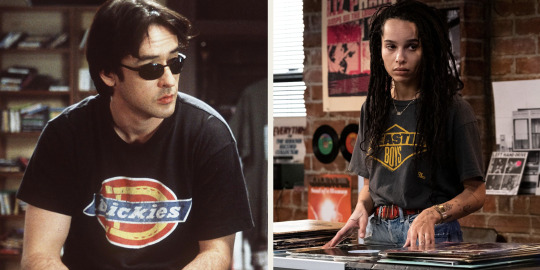
It’s easy to forget now that at the beginning of 2020, before the pandemic had taken hold of our consciousness, for a brief moment, High Fidelity was back. Not only did Nick Hornby’s debut novel and Stephen Frears’ film adaptation celebrate major milestones this year — 25th and 20th anniversaries, respectively — but a TV adaptation premiered on Hulu in February. In light of all of these arbitrary signposts, multiple thinkpieces and remembrances litigated Hornby’s original text on familiar, predictable grounds. Is the novel/film’s protagonist Rob actually an asshole? (Sure.) Does Hornby uphold his character’s callous attitudes towards women? (Not really.) Hasn’t the story’s gatekeeping, anti-poptimist approach to artistic taste culturally run its course? (Probably.) Why do we need to revisit this story about this person right now? (Fair question!)
Despite reasonable objections on grounds of relevancy, enough good will for the core narrative—record store owner seeks out a series of exes to determine a pattern of behavior following a devastating breakup—apparently exists to help produce a gender-flipped streaming show featuring updated musical references and starring a decidedly not-middle-aged Zoë Kravitz. I only made it through six of ten episodes in its first (and only) season, but I was surprised by how closely the show hewed to High Fidelity’s film adaptation, to the point of re-staging numerous scenes down to character blocking and swiping large swaths of dialogue wholesale. (Similarly, the film adaptation hewed quite close to the novel, with most of the dialogue ripped straight from Hornby.) Admittedly, the series features a more diverse cast than the film, centering different experiences and broadly acknowledging some criticisms of the source material regarding its ostensibly exclusionary worldview. Nevertheless, it seemed like a self-defeating move for the show to line itself so definitively with a text that many consider hopelessly problematic, especially considering the potential to repurpose its premise as a springboard for more contemporary ideas.

High Fidelity’s endurance as both a piece of IP and a flashpoint for media discourse is mildly baffling for obvious reasons. For one thing, its cultural milieu is actually dated. Even correcting for vinyl’s recent financial resurgence, the idea of snooty record store clerks passing judgment on customer preferences has more or less gone the way of the dodo. With the Internet came the democratization of access, ensuring that the cultivation of personal taste is no longer laborious or expensive, or could even be considered particularly impressive (if it ever could have been). Secondly, as one might imagine, some of Hornby’s insights into heterosexual relationships and the differences between men and women, even presented through the flawed, self-deprecating interiority of High Fidelity’s main character, are indeed reductive. Frears’ film actually strips away the vast majority of Hornby’s weaker commentary, but the novel does include such cringeworthy bits like, “What’s the deal with foreplay?” that are best left alone.
Accounting for all of that, though, it’s remarkable how many misreadings of Hornby’s text have been accepted as conventional wisdom. It’s taken as a given by many that the novel and film earnestly preach the notion that what you like is more important than what you are like when, in fact, the narrative arc is constructed around reaching the opposite conclusion. (The last lines of the novel and film are, literally, “…I start to compile in my head a compilation tape for her, something that's full of stuff she's heard of, and full of stuff she'd play. Tonight, for the first time ever, I can sort of see how it's done.”) That’s relatively minor compared to the constant refrain that Rob’s narcissism goes uncriticized, even though the story’s thematic and emotional potency derives from what the audience perceives that Rob cannot. To put it bluntly, High Fidelity’s central irony revolves around a man who listens to music for a living being unable to hear the women in his life.

While Hornby’s prose immerses the reader in Rob’s interior monologue, providing ample room for the character to spout internal justifications of his behavior, the novel hardly obscures or conceals this conclusion. Moreover, the film makes it unavoidably explicit in numerous scenes. Rob (John Cusack) triumphantly pantomimes Rocky Balboa’s boxing routine soundtracked to Queen’s “We Are The Champions” after his ex-girlfriend Laura (Iben Hjejle) confirms she hasn’t yet slept with her new boyfriend Ray (Tim Robbins), but doesn’t hear the part where she says she prefers to sleep next to him. When Laura informs Rob that she did eventually sleep with Ray, Rob completely falls apart. In an earlier, more pointed scene, Rob goes out with his ex-girlfriend from high school (Joelle Carter) to ask why she chose to have sex with an obnoxious classmate instead of him. She venomously informs him that he actually broke up with her because she was too prudish, an abrupt, cruel bit of business we actually witness at the film’s beginning. It was in her moment of heartbroken vulnerability that she agreed to quickly sleep with someone else (“It wasn’t rape because I technically said, ‘Okay,’ but it wasn’t far off,” she sneers), which ultimately put her off sex until after college. Rob doesn’t hear this explanation or the damning portrait of his teenaged self. Instead, he’s delighted to learn that he wasn’t actually dumped.
These are evidently low character moments, one’s that are comedic in their depiction of blinkeredness but whose emotional takeaways are crystal clear, and one’s that have been written about before. My personal pick from the film, though, comes late when Rob attends Laura’s father’s funeral. He sits in the back and, in typical fashion, turns to the camera to deliver a list of songs to play at his funeral, concluding with his professed wish that “some beautiful, tearful woman would insist on ‘You’re The Best Thing That Ever Happened to Me’ by Gladys Knight.” It’s a really galling, egotistical moment that still makes me wince despite having seen the movie umpteen times. Yet, it’s immediately followed by the casket being lowered to the ground as Laura’s sobs ring out in the church. In a movie defined by John Cusack’s vocal timbre, it’s one of the few times when he completely shuts up. From two-thirds down the center aisle, Frears’ camera pushes into Cusack’s face until tears in his eyes are visible, but what you really see is an appropriately guilt-ridden, ashamed expression.

However, none of this evidence carries any weight if your objection to High Fidelity is that Rob suffers no material consequences for his behavior. While Rob is frequently called out for his actions, he is never actively punished. He doesn’t, say, receive a restraining order for continually calling Laura after they’ve broken up or end up alone mending a permanent broken heart because of his past relationships. By the end, Rob and Laura get back together and Rob even starts an independent record label on the side. It’s a stretch to characterize Hornby’s High Fidelity as a redemption tale, but it is a sideways rehabilitation narrative with a happy ending that arises at least partly out of mutual exhaustion.
Those two elements—Rob’s asshole recovery and the exhausted happy ending—rarely seem to factor into High Fidelity discourse. Granted, there’s credence to the idea that, socially and culturally, people have less patience for the personality types depicted in High Fidelity, and thus are less inclined to extend them forgiveness, let alone anything resembling retribution. I suppose that’s a valid reaction, one against which I have no interest in arguing, but it’s somewhat ironic that High Fidelity has endured for reasons that have nothing to do with its conclusions regarding inflexible personal principles and the folly of escapism. Both the book and film are specifically about someone who slowly comes to terms with accepting reality rather than live in a world mediated by pop cultural fantasies whose unrealistic expectations have only caused personal suffering. It’s not unfair to characterize this as a fairly obvious epiphany, but considering we currently live in a world dominated by virtual echo chambers with an entertainment culture committed to validating arrested adolescence, it retroactively counts as “mature” and holds more weight than it otherwise should.
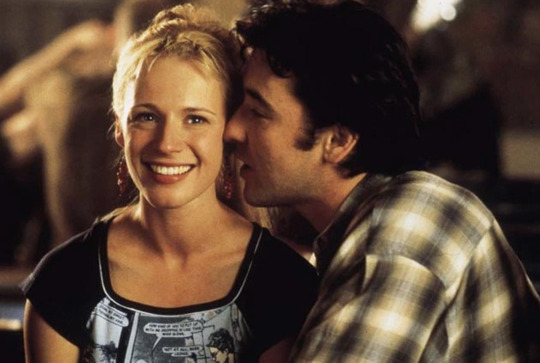
Near the end of High Fidelity, the book, after Rob and Laura have gotten back together in the aftermath of Laura’s father’s death, Hornby includes a chapter featuring five conversations between the couple unpacking the state of their relationship. During the third conversation, Rob and Laura fight about how she doesn’t care about music as strongly as he does, catalyzed by Rob’s objection to Laura liking both Solomon Burke and Art Garfunkel, which, in his mind, is a contradiction in terms. Laura finally admits that not only does she not really care about the difference between them, but that most people outside of his immediate circle of two don’t care about the difference, and that this mentality is indicative of a larger problem. It’s part of what keeps him stuck in his head and reluctant to commit to anything. “I’m just trying to wake you up,” she says. “I'm just trying to show you that you've lived half your life, but for all you've got to show for it you might as well be nineteen, and I'm not talking about money or property or furniture.”
I fell for High Fidelity (first the movie, then the book) as a younger man for the reasons I assume most sensitive-cum-oblivious, culturally preoccupied straight guys do: it accurately pinpoints a pattern of music consumption and organizationally anal-retentive behavior with which I’m intimately familiar. I spent the vast majority of my early years listening to and cataloguing albums, and when I arrived at college, I quickly fell in with a small group of like-minded music obsessives. We had very serious, very prolonged discussions filled with impossibly strong opinions about our favorite artists and records. Few new releases came and went without them being scrutinized by us, the unappreciated scholars of all that is righteous. List-making wasn’t in vogue, but there wasn’t a song that passed us by that we didn’t judge or size up. I was exposed to more music during this relatively short period of time than I likely will ever absorb again. Some of these times were the most engaging and fun of my life, and I still enjoy discussing and sharing music with close friends, but I’m not such a true believer to fully feel comfortable with this behavior. It’s not entirely healthy on its own and definitely alienating to others, and there comes a point when you hear yourself the way a stranger might, or maybe even catch a glimpse of someone’s eyes when you’re midst rant about some stupid album, and realize, “That’s all there is of me. There isn’t anything else.”
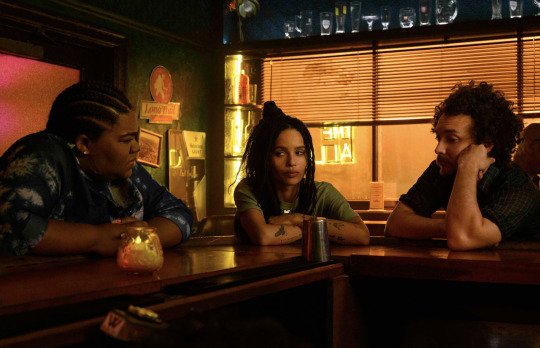
This is what Rob proclaims to Laura in the conversation when she tells him she was more interested in music during their courtship than she is now. It’s a patently self-pitying statement on his part that doesn’t go unchallenged by her in the moment or bear fruit in the rest of the novel. Yet, it’s this type of uncomfortably relatable sentiment that goes under-discussed. If High Fidelity will continue to have a life well after its cultural moment has passed, then it’s worth addressing what it offers on its own terms. Near the end of the book, Laura introduces Rob to another couple with whom he gets along quite well. When the evening comes to an end, she tells him to take a look at their record collection, and it’s predictably filled with artists he doesn’t care for, e.g. Billy Joel, Simply Red, Meat Loaf. “'Everybody's faith needs testing from time to time,” Laura tells him later when they’re alone. Amidst Rob’s self-loathing and sullen pettiness, Hornby argues that one should contribute in some way rather than only consume and that, at some point, it’s time to put away childish ideas in order to get the most out of life. It’s an entirely untrendy argument, one that goes against the nostalgic spirit of superhero films and reboot culture, but it doesn’t lack merit. Accepting that some values aren’t conducive to a full life, especially when it’s shared with someone else, doesn’t have to mean abandoning interests or becoming an entirely different person. It just means that letting go isn’t an admission of defeat.
It’s why I’ve always found the proposal scene in the film to be quite moving, albeit maybe not specifically romantic. It plays out similarly in both the book and the film, but the film has the added benefit of Cusack and Hjejle’s performances to amplify the vulnerability and shared understanding. Laura meets Rob for a drink in the afternoon where he sheepishly asks if she would like to get married. Laura bursts out laughing and says that he isn’t the safest bet considering he was making mixtapes for some reporter a few days prior. When asked what brought this on, Rob notes that he’s sick of thinking about love and settling down and marriage and wants to think about something else. (“I changed my mind. That’s the most romantic thing I’ve ever heard. I do. I will,” she sarcastically replies.) He goes on to say that he’s tired of fantasizing about other women because the fantasies have nothing to do with them and everything to do with himself and that it doesn’t exist never mind delivering on its promise. “I’m tired of it,” he says, “and I’m tired of everything else for that matter, but I don’t ever seem to get tired of you.”

This sort of anti-Jerry Maguire line would be callous if Laura didn’t basically say the same thing to him when they got back together. (“I’m too tired not to be with you.”) It’s possible to read this as an act of mutual settling, but I always thought Hornby’s point was personal growth and accepting one’s situation were intertwined. The key moment in High Fidelity, the film, comes when Laura finds Rob’s list of top five dream jobs. (In the book, Laura makes Rob compile the list.) At the bottom of the list, after such standard choices like music journalist and record producer, lies architect, a job that Rob isn’t entirely sure about anyway. (“I did put it at number five!” he insists.) Laura asks Rob the obvious question: wouldn’t you rather own your own record store than hypothetically be an architect, a job you’re not particularly enthused with anyway?
It’s Laura who convinces Rob that living the fifth-best version of your life can actually be pretty satisfying and doesn’t have to be treated like a cruel fate worse than death. Similarly, Rob and Laura both make the active decision to try to work things out instead of starting over with someone else. Laura’s apathy may have reunited them, and Rob’s apathy might have kept him from running, but it’s their shared history that keeps them together. More than the music and the romance, High Fidelity follows the necessary decisions and compromises one has to maneuver in order to grow instead of regress. “I've been letting the weather and my stomach muscles and a great chord change in a Pretenders single make up my mind for me, and I want to do it for myself,” Rob says near the end of Hornby’s novel. High Fidelity’s emotional potency lies in taking that sentiment seriously.
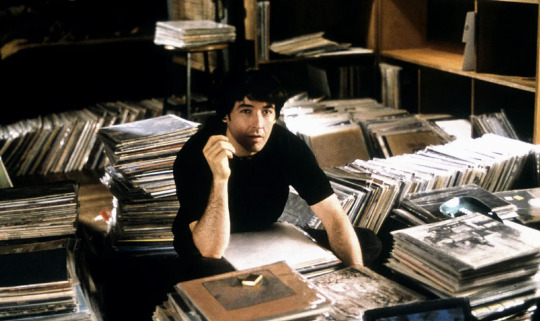
#high fidelity#nick hornby#stephen frears#john cusack#zoe kravitz#90s films#oscilloscope laboratories#musings#beastie boys#music#music movie#vinyl#vinyl film#jack black#tim robbins#adam yauch#vikram murthi#film writing#Film Criticism#hulu#reboot
40 notes
·
View notes
Text
Studying “A Study in Emerald”
At my grandmother’s house, stacked together with other books underneath a side table in her office, was a thick leatherbound volume with golden engraved lettering. SIR ARTHUR CONAN DOYLE, it said, in large letters on the cover. And in smaller print: The Celebrated Cases of Sherlock Holmes.
I was eight or nine years old, and as soon as I opened the volume I was hooked. I brought it along as I rode with my grandmother doing errands. I asked her if I could have the book, and with her permission took it home with me. I hadn’t finished it by the time summer camp rolled around, so I tucked it into a suitcase and read bits of it at the end of activity-filled days before going to bed. I hardly even glanced at any other books until I had turned the last page.
Since I have re-read the stories so many times over the years, the solutions to the mysteries are no longer a surprise to me. I had read them for the mysteries, the first time. But now I read them for other reasons—the relationship between Holmes and Watson, the atmosphere of horror and dread that ACD does so well, the breadcrumbs of character arcs in the main and recurring characters, and the way the characters seem both dated and modern, sometimes in the same sentence.
All that is to say, I love Sherlock Holmes. And several months ago I found that Neil Gaiman had written a Sherlock Holmes story. I’ve read a few Gaiman works and was curious to see how he treated some of my favorite fictional characters, so I downloaded it. And read it. And loved it. And in this analysis, I will convey my enthusiasm by explaining just how amazing this story is.
NOTE: this will be a multi-part analysis, with one post for each part of “A Study in Emerald.” (Parts 2 and 3 will be covered in one post.) There will also be some follow-up posts with additional thoughts at the end.
You should 100% read the story before continuing because A) it’s awesome and B) there is a twist that I will be getting into pretty quickly that is much better if you experience it for yourself first.

Part 1: The New Friend
The beauty of this story is that knowing the Sherlock Holmes canon works both for and against the reader. If you’ve read the canon, you will recognize the references to certain characters or details or plot points—but at the same time, those moments of recognition can lead you to draw conclusions that Gaiman fully expects you to make but are in fact inaccurate.
Right off the bat, the title of “A Study in Emerald” is just one word away from the title of the very first Sherlock Holmes story. This, along with the first page or so of the narrative, primes us to approach the tale as a straightforward Sherlock Holmes pastiche, like the countless others that have been written: “Sherlock Holmes in space!” “Sherlock Holmes as a kid!” “Sherlock Holmes in the far future!”, where everything is basically the same, just with a natural transformation of entities to match the “hook” of the pastiche—so instead of smoking, kid Holmes sucks on lollipops or the like. The “hook” of this particular pastiche first manifests with the narrator’s war wounds being the result, not of bullets and fevers as in the canon, but of underwater creatures that suck the vitality out of one’s limbs.
“Okay,” we as readers familiar with Sherlock Holmes say to ourselves. “So Holmes and Watson, but in a world of the supernatural. Got it. Nice twist, Gaiman. I’m ready to see what you do with this.”
As I said, Gaiman uses your Sherlock Holmes knowledge against you in constructing this tale. The narrator has a shoulder wound as a result of his wartime experiences, just as Watson does in A Study in Scarlet—the circumstances of his injury are changed to be more fantastical, of course, but we accept that because we have acclimated ourselves to what we think is the whole of this seemingly straightforward premise (Sherlock Holmes, but with Lovecraftian elements). After all, we have the two men meeting in the university laboratory, both interested in sharing rooms, and we get the iconic line, “You have been in Afghanistan, I perceive.” We get the familiar prospective-roommates-share-vices exchange. It’s not the same as the original, but we don’t read Holmes pastiches for the exact same lines we could get by rereading the original stories. Besides, the exchange hits enough check marks for what we already know about Holmes (since we’re familiar with canon) that instead of the change setting off alarm bells, we’re busy patting ourselves on the back for recognizing references and approvingly nodding in response to Gaiman’s demonstrated knowledge of the stories. After all, Holmes did shoot bullets into the wall once. And he is private and easily bored, and selfish as well at times. These are revelations about Holmes’s character that are shared in later stories, after A Study in Scarlet, but they match the whole of his character that we know since we have the entirety of the canon under our belts, so it’s quite clear to us that this man the narrator meets is indeed Sherlock Holmes.
By condensing the characteristics of Holmes that were originally revealed over the course of several publications into one dialogue exchange, the plot is able to move speedily along while reinforcing our initial understanding of this man’s identity. However, presenting these characteristics in this manner also leads to some contradictions with canon, which means that things are just a little bit off. Holmes is established in later stories as having irregular habits, but in A Study in Scarlet, the specific story that this dialogue exchange is echoing, it’s Watson who “get[s] up at all sorts of ungodly hours.” Here the one who admits to “keep[ing] irregular hours” is the non-soldier, when in A Study in Scarlet Holmes is actually quite regular in his schedule (he doesn’t really maintain that behavior beyond that first story, but still). On a more complex level—and I might be reading too much into this particular point but it is striking to me as someone who has spent several years with roommates—there is the detail that the detective in “Emerald” informs the narrator right off the bat that he will need to use the sitting room to see clients. In A Study in Scarlet, Holmes does not inform Watson of this fact in the initial cross-examination. It’s only after they move in together and Watson starts getting (politely) kicked out of the sitting room on a semi-regular basis that Watson even learns Holmes is a person who has a visiting clientele. This is a rather major thing for a prospective roommate to know. Failing to mention this to Watson while still detailing his smoking habits and propensity for chemical experiments is a rather egregious omission on Holmes’s part, as anyone who has had to get used to a new roommate will tell you. So we have two instances where the information about the detective matches our overall conception of Holmes, but it is presented in a way that goes directly in opposition to how it was originally presented in canon—where what we are reading is both right and wrong at the same time.
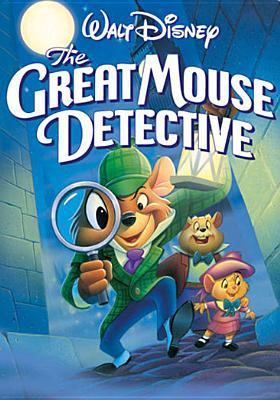
Let’s continue on in the story. Our “heroes” move into the same old apartment on Baker Street, which further solidifies the straightforward Holmes in a Lovecraftian world explanation we as readers have formulated for the story. We go through the same “narrator wonders what his mysterious roommate does for a living” steps that we remember from A Study in Scarlet, albeit, again, condensed. And the mystery plot begins as the two roommates eat breakfast, just as in that very first story.
Keen readers might take note of the fact that it is Inspector Gregson, not Inspector Lestrade, who brings the mystery in A Study in Scarlet to Holmes’s attention. Considering that Lestrade made more appearances in the canon and became Holmes’s default police contact, Lestrade’s presence here can simply be chalked up to Gaiman paying homage to the whole of the canon, not just the first story. Alternatively, this is yet another instance of things being ever so slightly wrong when compared to the events we are all familiar with.
You’ll notice that, having successfully (because on first read you are likely not reading as critically as I am now with this analysis) lulled us into a false sense of security regarding the premise of this story and the identities of its characters, Gaiman starts to drop more references to other specific stories besides A Study in Scarlet, as well as more direct hints (which require much less complex analyzing than I have done in previous paragraphs) as to who our narrator and his detective friend truly are.
The first* direct hint is so subtle that I don’t think I even picked up on it the first time I read the story. It’s when Lestrade suggests he talk to the detective privately. The content of the exchange is, once again, familiar to a Sherlock Holmes reader—how many times have we seen Holmes assure a client that Watson can be confided in just as well as himself (see: “A Case of Identity”), or refuse to let Watson excuse himself as a case begins to unfold (see: “A Scandal in Bohemia”)? The hint lies in the description of the narrator’s friend when he dismisses Lestrade’s suggestion: “his head moved on his shoulders as it did when he was enjoying a private joke.” Gaiman can’t show his hand too early, so this hint is extremely oblique. The key is the phrasing: “his head moved on his shoulders” is a rather odd and roundabout description, which could much more easily be rendered as “he shook his head” or something to that effect. But in using this wording, Gaiman ever-so-lightly echoes the description of a certain someone a couple pages into “The Final Problem”:
His shoulders are rounded from much study, and his face protrudes forward, and is for ever slowly oscillating from side to side in a curiously reptilian fashion.
We have some more general Easter egg references to the canon—the detective’s slight dissatisfaction when someone (Lestrade in this case) remarks on the simplicity of his reasoning after it is explained, and the Study in Scarlet-specific “only one in the world” consulting detective explanation. And then we have this terrific bit. Our narrator asks the detective if he really wants him to come along. The detective’s response is as follows:
“I have a feeling that we were meant to be together. That we have fought the good fight, side by side, in the past or in the future...from the moment I clapped eyes on you, I knew I trusted you as well as I do myself.”
It’s terrific because it’s a summation of how Holmes and Watson are viewed by their fans. They belong together. Victorian London, World War II, 21st century New York, 22nd century London, as mice, as dogs, we’ve seen them in countless adaptations, and despite the change in locale or era or gender or species or countless other circumstances, they are always inseparable, always a force unto themselves, incomplete without the other. Of course this is Holmes and Watson. How could these words apply to anyone else?
The detective’s speech here appeals to our Holmes devotee sensibilities much more than canon Holmes’s response to Watson asking much the same question in A Study in Scarlet:
“You wish me to come?”
“Yes, if you have nothing better to do.”
Which is a rather unexceptional start to a partnership for the ages. The way “Emerald” tugs at the heartstrings, however, is dangerous—it pulls us further down into acceptance of the twisted world and characters that surround us.
*I will come back to this in a later post!
20 notes
·
View notes
Text
Outlining and plot development
Wherever you fall on the spectrum of pantser to plotter to throwing pens at your computer and hoping your story will write itself (that’s a self callout) here is a guide (that no one asked for!) to plotting your story!
Is this going to be an exhaustive list of everything you have to do to write the next NYT bestseller? no. This is, like everything else on this blog, a summary of ideas. They won’t all apply, they won’t all work for everyone, they won’t cover everything, but it’s a start. That’s the best part of the writing prompt business, you supply the inspiration and other people do the hard work!
Okay, let’s get into it
1. What story are you telling?
Now, I’m going to be really honest with you here. If you don’t know this, you have a lot of work to do. And that’s okay!
Take some time to flesh out your idea. Wherever you start, I promise you there’s more in your head waiting to be discovered. Take out a piece of paper, open up a new document, write it on your walls! (we will NOT be covering lost security deposits!) and do some brainstorming.
The basic elements of a story are
- characters
- conflict
- resolution
- plot twist(s)
- setting/background (think physical setting where the story takes place and informational setting, worldbuilding, context, etc)
We have a post on developing characters here and posts on the other elements are in the works! I wish I could say they’ll be posted in a timely manner but . . . they won’t, they just won’t lmao I’m sorry
You don’t have to have all of these points completely figured out before you move onto plotting! In fact, you shouldn’t! Or, if you think you do, be open to change because it’s important to remember that all these points, especially characters, are heavily affected by the plot!
2. How are you telling this story?
This is for the technical stuff.
What does the formatting look like? Are you breaking it up into chapters? Parts? Not everyone writes drafts like this so that’s okay, maybe you’re going to write out of order, maybe you’ll break it up after, whatever works for you though I highly encourage you to switch it up every now and then and see if anything works better for you than what you’ve been doing.
3. Consider the usual structure of a story
There are a lot of these, try not to get overwhelmed or too snagged on any of them but here are two interesting ones!
The first is the three act structure, we’re all pretty familiar with this.
Think of an action movie, it starts with a small introduction, it introduces a main character, side characters, stakes, a setting. Then the conflict happens!
BAM! the beloved spy is thought to be a traitor, their family is being held hostage and they have to betray everyone they work with to save them, they have a horrible secret that’s coming back to bite them in the ass. Whatever it is, this moves us into the second act, the journey, the trials, whatever you want to call them.
This is the largest part of the story and the tension continues to build until we reach the climax of the story. They save they world, or their family, or themselves, or they don’t. Whatever it is, this results in the final act where the action falls, everything is resolved, and the story is over (unless a sequel is set up but that’s a whole other issue), you get the idea.
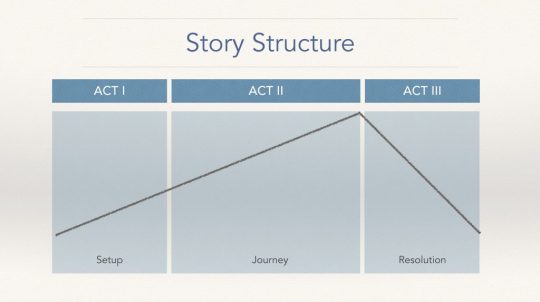
(image found here)
Another popular structure is the hero cycle which echoes the three act structure but focuses particularly on, you guessed it! Heroes!
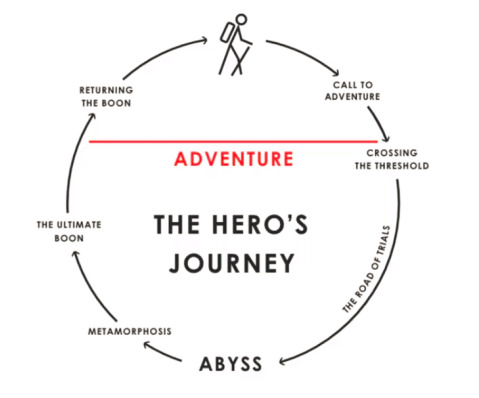
(image found here)
Let’s take a popular storybook hero as an example here, Percy Jackson. (Needless to say, there will be spoilers if you, for some terrible reason, have not read Percy Jackson and the Lightning Thief)
All of these milestones are a little debatable but I’ll pick a few to use as examples.
Percy begins his story, he is introduced as a character, I could write a whole essay on Percy’s development and the incredible writing of Rick Riordan (lmao, I have) but I’ll try to keep this brief.
When his mother is kidnapped, he has a call to action, a goal: to save his mother.
He crosses a very literal threshold into Camp Half Blood and his story begins.
He goes through many trials and tests, Medusa, St. Louis, Waterland, the Lotus Hotel, and so on.
It’s called abyss here but I learned it as the final battle, in PJO Percy faces Ares. This is very similar to the climax and falling action of the three act structure. Following this, loose ends are tied up, characters complete their journeys and their arcs, and the hero returns.
It’s very fascinating, I highly recommend reading up on it. Again, you’ll find many many stories you read follow this structure.
There are literally so many of these and if you’re interested, here’s a link to some more. Keep in mind, your story doesn’t have to fit these perfectly but even if you’ve planned out a story without these in mind, you’ll probably find most, if not all of it, fits pretty well within these lines. They can also help with pacing, if your first act is most of your story, you may need to move your conflict and stakes up earlier in the story to maintain interest.
4. Now you outline
Obviously not everyone outlines. Personally, I cannot understand this at all. Now, since this entire post is about plotting and outlining, we’re not really going to talk about pantsing because . . . that kind of defeats the point of this post. But! If you have anything to say about pantsing, tips, tricks, personal experiences, by all means, reblog this and add them! I don’t have any experience with pantsing so I really don’t have much to say on the topic.
There are lots of different ways to outline a story. Personally, I recommend starting big. Think acts and parts, find your conflict and your stakes, you know you have to introduce your character and the world, how are you going to do that? That goes first, then stakes, so we care and then conflict, so the thing we care about is, well, at stake.
Chronologically, you have the journey now, but let’s take a minute to talk about the end.
4.5. How does it end?
Even if you’re a pantser, I really, really recommend that you know how your story ends. Having a point you want to get to can make a world of difference in the process of planning and writing a story. Sure, you can run a marathon without setting an end point, but it’ll slow you down if you’re always checking to see what mile you’re on.
So how does it end? Happy? Sad? Who is there? Logically speaking, your antagonist and protagonist should usually be present, supporting characters? How does it end, does the protagonist prevail and save the day? Is it a cliff hanger? If it’s a race to an end, who gets there first and what does it mean?
Find your ending, and then work on your middle.
5. The smaller picture
If you have the main points (a beginning and an ending, the conflict and the stakes, your characters), now you can start thinking about the smaller details.
You have an ending so what needs to happen to get your character(s) there? Consider your minor characters, where do they come in? Make sure they have a purpose!
Keep in mind, in the first draft and even the second and for as long as you need it to be, your outline is fluid. You may very well be writing your project and realize the pacing isn’t right, or that something needs to happen later in the story, or that you need to add a scene. Then, when it comes to editing and redrafting, it’s likely that you’ll change it even more.
Try not to get caught up in it being perfect, that’s not what first drafts are for. Make it workable and approach it with an open mind, things are going to change, that’s a given.
6. Write your story!
A few notes on this. As one of my favorite authors, Neil Gaiman says, “the process of doing your second draft is the process of making it look like you knew what you were doing all along.”
So once you’re done with your first draft and the time comes to redraft it and you’re working on your outline, now is the perfect time to add your foreshadowing and rework your plot twists. This isn’t to say they don’t have a place in your first draft, they do, give it your best shot! But your story is fluid and your outline and plans are bound to have changed and your editing stages are the best stages to really make sure foreshadowing, plot twists, and all or acts or hero cycle, or whatever you want to call it, works together.
And this concludes another guide that no one asked for. I hope you enjoyed it and if you have any suggestions for ones you’d like to see we currently have plot twists, endings, motivation, and more in the works!
Happy writing!
- Mod S
p.s. these can be found on our blog under the tag story development series!
#writing#ideas#inspiration#writing ideas#writing inspiration#stories#story ideas#story inspiration#plot development#outlining#the hero cycle#three act story#story structure#story development series#plot bunnies#story starters#story sparks
126 notes
·
View notes
Note
I've been in the fandom since forever and I've noticed the change where now some readers go to war with writers who write d/hr sex scenes as "too rough" or "she didn't consent" etc. It irks me because generally if you think about the two including their history and personalities, the first couple of times are going to be like "that" until they're on even ground. Wonder if you've seen this reading around or even in your reader's response to your scenes and how you feel.
I think in fandom we’re reading about these characters because on some level, they're our favourites. There are people who are here for a multitude of reasons: for the romantic ending canon that didn't give them, for more of their fave, to satisfy their id, to improve as a writer, all of the above, or something else.
The trouble is that a lot of people see 'This is emotionally satisfying for me' as 'good' and 'this isn't what I want' as ‘bad’.
Personally, I'm primarily here for the writing and story process, both as a reader and a writer. A huge part of what makes me stick around in fandom is because fanfic writers will do such unusual things that you’ll never see in mainstream/published fiction that are restricted to safe predictable plot structures that replicate all the elements of a preexisiting best-selling YA novel.
For me what’s fun about the writing process is developing complete and congruent psychological portraits of characters, and trying to do something different(ish) each time. I’m trying to become the best writer that I can be, and that means writing different variations of things and pushing myself, rather than reiterating a characterization from fic to fic. Authors can write interpretations that I don't necessarily “agree with” but if the writing is compelling and doesn't contain holes where characterisation falls apart, and they've actually meshed the premise with canon, I'll go "That was GREAT" even if it's not something I’d write.
I don't really have a particular “way” I think dramione’s first time should be. I’ve already written it a few different ways depending on the story context.
All that said, one thing I’ve noticed in Dramione, having been reading for a long time too, is that the stories written now reflect the fact that the authors in the Dramione fandom are older now. It’s a less teen-age romance, slap slap kiss stories that predominantly populated Dramione in the early 2000’s. Authors now who are writing “romantic stories” are wanting to write romance that holds up under their adult perspective, which means exploring things like consent and redemption more explicitly and not “romanticizing” bad or abusive behavior that might have seemed hot in high-school but now they have more perspective and experiences with relationships. (I used to love professor-student relationship fics as a teen, but then when I had an authority figure try to sleep with me, I stopped enjoying those fics because most of them were primarily occupied with the kink and didn’t address the issues.)
People are also a lot more aware nowadays about the importance of consent. I personally enjoy the challenge within certain stories of making consent a fluid aspect of the sex scene.
However, that isn’t to say all stories need to be healthy and romantic. The fun thing about fiction is the ability to explore all kinds of things within the safe confines of the imagination. Of course there are purity police who don’t think any bad things should ever be written about, not to mention readers who can’t distinguish that a character’s POV is not an authorial endorsement.
Personally, I read pretty widely within fandom, I don’t have many squicks and barely any triggers. I will read very dark fic that knows what it’s doing. But I do tend to nope out of fics that don’t seem conscious of their subject matter.
I’m completely willing to read a story with non-con and an abusive relationship assuming there’s a plot to it, but only if the author seems to know that they’re writing an abusive relationship (again I’m not conflating authorial endorsement with narrative POV/unreliable narration). That’s because I’m usually reading for the psychological arc, and if a fic isn’t including the relevant emotional beats because the author doesn’t realize what they’re writing, or doesn’t understand the emotional complexity of it, then it’s not a very fulfilling story for me to read.
I've stated this a number of times before, but sweet, pastoral fantasies are really not my thing. I find tension and turmoil far more compelling to read and write about. I like complicated relationships, and characters with issues that they have to deal with and learn to overcome together.
I think it can be easy to get locked into one interpretation of the characters, and while there are themes and dynamics I realise I tend to explore more often than others, I try not to limit myself to only one interpretation.
I think that writers should explore what's compelling to them, and I think that fiction is a great place to explore dark themes.
89 notes
·
View notes
Note
what’s YOUR outline process? Just wondering. It’s a tough thing to master in my experience
I don’t usually make outlines for oneshots, but for chaptered fics I definitely do. It honestly took me a few years to figure out my process (I’ve been writing for a long time), but by now I have a pretty hard-nailed way to do it. Here are the basic steps:
Establish key themes.
After deciding on the genre (that’s normally how it starts - fluff/smut/angst etc.), I try to define (with words) what themes I want to appear in the story. Often these are how I get ideas for the plot, as I’ve found to be the case with most writers. Betrayal, self-identity, motivational issues, and shyness are some themes to look for in upcoming stories!
Write out character insights.
If characters that I’m writing don’t have clear motivations, it’s hard for me to write them well. This is especially true for characters that are mostly meant to be projections. Link (Breath of the Wild) and Nagisa (Assassination Classroom) are two good examples of this. Even when I’m writing OCs to put into stories, they need clear arcs. I try to write out (again, in words)(I cant express how important that is when planning a story lol) where I want the characters to be at the beginning and end of the story.
Create (a) “brainstorm page(s)”.
I sometimes take up multiple pages to flush this out in scribbles of notes. Often these are story elements, character arcs, character ideas/sketches. I love lists, so a lot of these pages have bulleted lists, mind maps, and relationship trees. When I’m done with my BOTW murder mystery, I’ll happily share some of these notes. :)
Make a chapter outline.
Chapter outlines! These took a while for me to get the hang of. By now, I’ve learned that if I say “I want this story to fit into 20 chapters” and then try to fit my story into 20 chapters, the plot gets rushed at the end. Instead, I effectively write out the story in bullet-list form (again with the lists), and cut them into segments (chapters) where the story has appropriate pauses. This way, although the chapter structure isn’t symmetrical, it does tell the story in a complete and satisfying way, for both me and for those who read my stories. At the top of each chapter segment, I put a note of what I want to happen in said section of the story.
And then...y’know...
I have to write it.
Tends to be the hard part, dunnit.
#oh well#at least i’m getting better at that#this was fun to answer#thank you!#ask#fanfic writing#personal
24 notes
·
View notes
Text
Character Analysis: Asuka Langley Sohryu
disclaimer:
this was originally written by @ritsumaya in 2014 but most of the post was lost due to them deleting. (and that was devastating personally as their meta posts were amazing. we lost the equivalent of the nge library of alexandria) this is what i’ve been able to salvage / copy over from various archives.
i will edit / delete this post and relink it to their own if ritsumaya ever decides to reupload this again themselves.
also, if you’re not interested in reading this essay, press J on your keyboard to advance to the next post on desktop. if you’re on mobile... i’m so sorry.
onto the original text:
Buckle up. It’s time to go on a massive analysis of Asuka Langley Sohryuu, or How Most of the Casual Fandom Gets Her Wrong.

Featuring!
The importance of pilothood to Asuka.
Her relationships with Kaji, Shinji, and Rei.
The meaning of the “Hell Kitchen” scene in End of Evangelion.
An explanation of histrionic personality disorder.
And so much more!
Warnings for suicide, gore, choking, mentions / allegories of rape and pregnancy, discussions of mental illness, thanatophobia, menstruation, nudity, basically any trigger warnings for Evangelion etc. etc.
It’s also very long, clocking in at twelve thousand four hundred forty-seven words. If I miss anything, let me know.
I’m limiting the discussion to Sohryu, from the anime series, rather than Shikinami, from the film series, because Shikinami is a wholly separate character that bears only a physical and superficial personality resemblance to Sohryu.
Okay, so lets get goin'!
As part of the Contact Experiments, Asuka’s mother, Kyouko Zeppelin Sohryu, was stripped of part of her soul, specifically of the “motherly” part. Rather than the tragedy of Yui’s full absorption into the EVA, NERV believed that they could activate the EVA whilst still keeping the mother alive. They didn’t intend to be complete monsters, you know.
Other than Rei and Shinji, explicitly selected from the beginning, Asuka was the first non-Gendo-essential pilot to be chosen out of the candidate pool. Note that none of the students at Shinji’s school has a mother, as Kensuke points out in the fourth episode because NERV has harvested their mothers’ souls in case a pilot is required. She clearly had talent and she intended to use it.
(By the way, the facts that Unit 00 and Unit 02 are Adam-based and do not possess full souls explain the rapid increase in Shinji’s synchronization scores. Asuka is indeed the best pilot; what occurred prior to the actual sync in End of Evangelion was mostly out of her hands.)
Unfortunately, the removal of part of her soul drove Kyouko insane. She began to talk to a small doll and take care of the doll in place of Asuka. In the meantime, Asuka’s father began an affair with Kyouko’s doctor, whom he would later marry.
By the time Asuka becomes the Second Child, she is absolutely desperate for her mother’s affection. She’s willing to break down rules and dismantle the world if it means that her mother will look at her. Just once. Just one look at her.
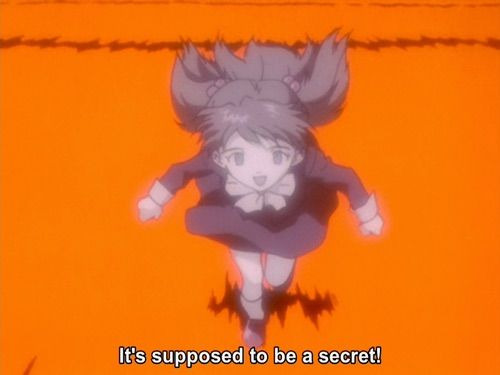
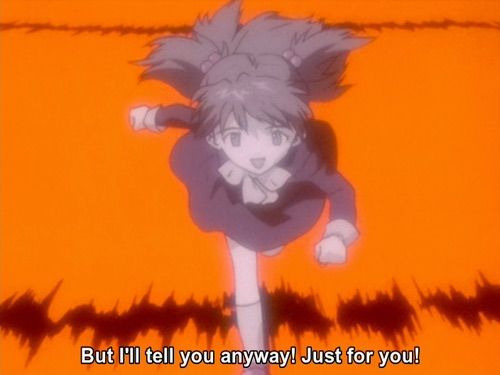
Her mother, having gone insane without the possession of the entirety of her soul, goes, well, insane. This has a horrific effect on young Asuka. Firstly, Asuka despises dolls. Secondly, and more importantly, Asuka has a desperate desire for attention, a desperate need for isolation, and a desperate ambition to prove herself independent. She doesn’t want to depend upon anyone ever again. She doesn’t intend to ever be put in the position of killing herself for anyone, ever again.
Quick recap: because her mother paid attention to a doll instead of her, Asuka became simultaneously starved for attention but also terrified of becoming dependent upon anyone. As a result, Asuka focuses her efforts on becoming akin to an adult.


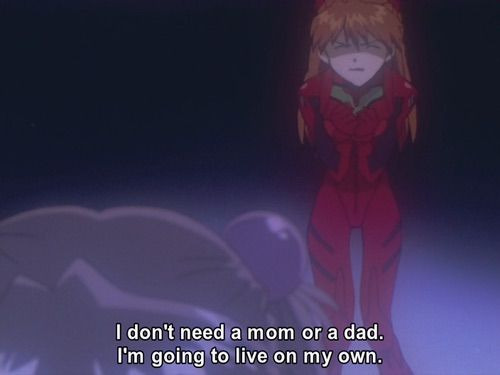
But, because society is fucked up, Asuka interprets growing up (for a woman) as being recognized as an adult by others. She also internalizes this by staking all of her worth upon her skills at piloting the EVA. In fact, the neural interface that links up the pilot to the EVA is a part of her typical design, to the point where, during Asuka’s version of the “step out naked from the shower” scene, she apparently showers with them on. Neither Shinji nor Rei, nor the other two pilots seen briefly in the anime, do the same. Only Asuka. While Shinji and Rei also stake their worth on piloting EVA, they do not do so at the visual intensity that Asuka does.
Now, I want to get a common misconception out of the way. Contrary to how quite a few fans would “diagnose” her, Asuka is not narcissistic. A little bit of the opposite, in fact: Asuka suffers from histrionic personality disorder, which can better be likened to dependent personality disorder in terms of root cause. Kaji’s another example of someone who has a histrionic personality; however, he is functional: While his personality contains histrionic elements, he does not have histrionic personality disorder like Asuka does.
Let’s take a quick look at the symptoms and behaviors associated with HPD. For this, I’m going to use Wikipedia, because we only need a basic overview (since we’re not actually diagnosing so much as comparing a fictional character’s personality):
Provocative (or seductive) behavior
Relationships are considered more intimate than they actually are
Attention-seeking
Influenced easily
Speech (style) wants to impress; lacks detail
Emotional liability; shallowness
Make-up; physical appearance is used to draw attention to self
Exaggerated emotions; theatrical
Using the mnemonic device PRAISE ME, we can examine some of the common elements of HPD. To generalize and paraphrase, whereas someone suffering from narcissistic personality disorder would actually believe themself to be better than anyone else, someone with histrionic personality disorder would only present themself as better than anyone else, while actually, internally, hating themself and so on and so forth.
Asuka very visibly refers to herself as the best pilot and takes sincere pride in that distinction. Likewise, she takes pride in the distinction of herself as the most popular girl in school, as when she notably calls herself that while speaking to Shinji. Yet, as we all know, Asuka in reality hates herself, which she repeats over and over again, especially over the later arcs of the series. But before we start a case by case analysis of HPD, let’s go back to her backstory.
Even before Kyouko actually performed the contact experiments, she did not pay much attention to her child, in the same manner of Ritsuko’s mother or Misato’s father, raising a child starved for attention.

Kyouko was driven insane by only having part of her soul within her, and Asuka’s father left to have an affair and marry the doctor. While Asuka appears very vicious and angry as she watches her mother coddle the young doll, she nonetheless is happy to see her mother and continuously attempts to perform to capture her mother’s attention.
Subsequently, Asuka became a pilot, and she informed her mother. However, her mother decided to commit suicide. In those final, chilling moments, we see the mother asking for Asuka (the doll) to commit suicide with her. Asuka’s response is forever etched into the memory of anyone who watches the scene:


She agrees to commit suicide along with her mother as long as her mother does not abandon her. While Asuka does not actually end up committing suicide, the experience shocks her to the core (pun not intended): She was perfectly and completely willing to die for the sake of someone else. At the funeral, Asuka tells herself that she will now become an adult so that she never has to depend upon anyone, ever again. Of course, being neglected as a child is one of the theorized causes of HPD. In order to compensate for the attention that she never received as a child, Asuka says that she’s going to be become an independent adult, and yet she decides to become an adult via external validation (a major theme of EVA, that: external validation will never actually assist you in attaining your own happiness; validation and love must be built internally up, in the entire idea of “How can you love others if you never even learned to love yourself?” and so on, but that’s another post for another time).
There’s a two-fold issue with her reasoning: first, she considers adulthood as sexual maturity. Herein lies a major crux of the issue, especially with regards to her relationships to Kaji and Shinji. Asuka can’t wait to grow up. In her impatience she intends to validate her attainment of adulthood via the validation of men around her, because such is what society taught her, and such is what her experiences with her father abandoning her mother and remarrying taught her (I would argue for a closeted lesbian Asuka myself).
Prior to arriving in Japan, Asuka and Kaji have an extremely telling exchange on the boat. Chronologically, this takes place just before episode eight. We begin with Asuka talking about Misato, saying that Asuka didn’t like Misato very much (this will be important for later, concerning Asuka’s relationship with Misato and her own relationship with herself). Kaji informs Asuka that she’ll probably make lots of new boyfriends in Japan and that the Third Child (e.g. Shinji) is a boy. Now, here’s the interesting part about that implication: Asuka has had boyfriends in Germany. And many of them, according to Kaji, as Asuka goes from boyfriend to boyfriend seeking validation and becoming increasingly frustrated when that doesn’t actually make her feel better.
Note: Kaji, and I, don’t literally mean “boyfriends”, but boys interested in Asuka as they are when she arrives in Tokyo-3. She is validated by the sheer number of people interested in her even as she snubs them and acts superior, but nonetheless none of them actually makes her feel validated. Remember that Asuka goes from the sole pilot in Germany to not even the best pilot in Japan, and consider how that works into the attention she receives and so on. Whenever I mention her “German boyfriends” again, keep this in mind: effortless boyfriends that she could make. Realistically, any attempts at dating would have gone down akin to the whole thing with Hikari’s friend—the unwanted boy stranded at a roller coaster.
Actually, this is an important point: Just like how Misato utilized sex in order to fulfill herself, so too does Asuka in a manner of speaking. However, the reasoning behind Misato’s and Asuka’s “deriving pleasure in lieu of actual happiness” is significantly different. Misato has wild sex because, as she explains, it’s nice to be needed, even if physically. Asuka does so because she herself wants to be validated. She doesn’t want to be “needed.” She wants people to pay attention to her and for her not to have to care about them, in essence. She wants to be “needed” but not in the way that Misato does (in an actual need) but in a manner that causes people to pay attention to her without her having to “need” them back. Misato wants a two-way street and settles for being needed physically when she can’t have said two-way street. Asuka wants a one-way street and when that still doesn’t make her happy, because that doesn’t exist, she can’t handle it.
Note: When I refer to Misato’s sexuality, I refer to the sexuality that Asuka sees, from her point of view / perspective. Misato, as revealed in her talk to Kaji, hasn’t actually been having wild sex, but Asuka assumes her to (and continues to assume that into Instrumentality).
Other analysts have pointed out the Three Faces of Eve / Three Faces of Adam symbolism that is repeated over and over again in EVA, from the MAGI supercomputers to Kaji-Gendo-Fuyutsuki. I won’t go too far into depth here, but essentially, Kaji represents the young, virile male; Gendo represents the cruel, warmongering male; and Fuyutsuki represents the old, wise male. It’s akin to the seven stages of man poem written by Shakespeare, and it’s also another post for another time. The most vital part of this is that Kaji represents the young, virile male, who is clearly the most sexually desirable of the three. Unlike the random boyfriends whom Asuka ensnares easily and who would probably go for anyone, Kaji is a Grown Adult. He drinks; he smokes; he has lots and lots of sex, and if he is interested in her, then surely Asuka will become the True Adult.
And so Asuka, inappropriately, attempts to seduce him.

Of course, he rejects her advances, because while Kaji is not the ideal guardian (as he has never truly been able to nurture positive relationships), he is neither a pedophile nor a hebephile. Unfortunately, to Asuka, this isn’t merely a rejection: It’s a denial of Asuka’s status as an adult. Kaji tells her, “You’re still a child.”
There is literally nothing that could cut Asuka more deeply than being called a child, because being a child is what almost killed her, what actually caused her to agree to commit suicide with her mother, driven to insanity. She can’t stand the thought of being dependent, of being a child. She’s going to grow up quickly now, isn’t she?
To reiterate: Asuka doesn’t actually love Kaji. Well, perhaps she does have a puppy crush on him, in the manner of young girls to attractive younger men (and, arguably, she probably has more of a hetero-compulsory “crush” on him than on Shinji).


I want to point out the entirely childish way that she says that. “Kissing, and even the stuff after that,” which is basically something repeated in some form or fashion by every sub upon which I could get my hands (to properly analyse EVA, I watched it using several different subs, from the official English release to crappy direct translations to fansubs, such that I could get a sense of the show overall, where one sub might mistranslate a given line). She can’t even start to talk about sex. She’s not actually ready for sex.

The framing of this shot is very interesting, because we’re treated to a full-frontal cleavage shot of Asuka. Now, Asuka has the smallest breast size of the three “EVA girls” (ugh), but in some of the other shots, such as the “Wall of Jericho” moment, her breasts look larger. On the other hand, in this shot she looks almost entirely flat-chested. The usage of the simple white bra simply furthers this point: She’s not an adult. She’s still a child, barely having grown out of her childhood, trying to become an adult far too soon. Now, she wants to become an adult in order to never have to become dependent upon anyone again. And yet, when she’s rejected instead of validated, she reverts back to her original basics of need:

Yeah. Look at her. Look at her, because her mother never did, because her father never did, because her mother substituted a doll for her, because at the end of it all, she feels like she doesn’t mean anything to anyone. And for that, she hates everyone. She hates other human beings. Most of all, of course, she hates herself.
So here’s the set-up: Asuka seeks validation for her becoming an adult, so that she can be independent and never have to depend on anyone again. This is what she tells herself on the outside. In reality, she craves attention. And this is why she hates herself, because of the paradox between her inherent hate of humanity and desire for isolation, and her desperate need for people to look at her because of the attention that she never received as a child.
Kaji rejects her. Ah, but a new contender rises upon the horizon: The Third Child. Shinji. Who is the only other boy around who is also a pilot, and a good one. When Kaji, the Actual Adult, fails her, she moves on to try to seduce Shinji, because he’s a good substitute (as a saviour of humanity and so on).
And speaking of Shinji, it’s about time to get into Asuka’s adventures in Japan.
Now interestingly enough, at the beginning of episode nine, wherein Asuka finally arrives in Japan, we get this interesting, prophetic exchange of students talking about Asuka:

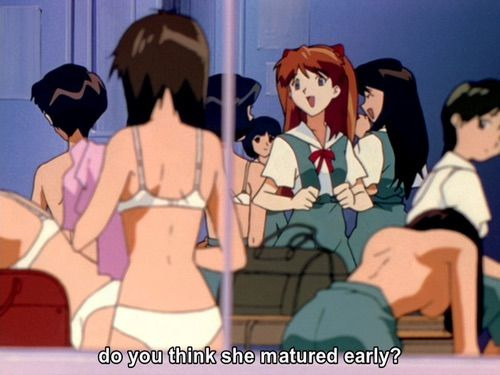
It seems to me from this that there’s a clear implication that Asuka undoubtedly made sure to carry herself so that the rumour would be true: She wants people to think that she matured early. And this, remember, is prior to us really getting a sense of who Asuka was, so it’s interesting to see the writers throw us this early tidbit. Of course, the other students reply pretty forcefully that she’s probably just here out of a broken heart.
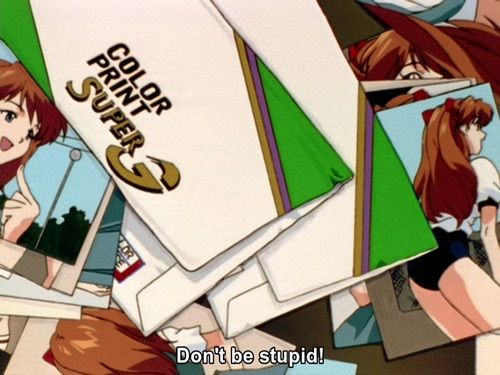
Now, at first, Shinji is not that happy to see Asuka. After all, she has been little but abusive to him. On the other hand, Asuka, who clearly thinks of herself as gorgeous (and the student body would agree), immediately responds to his unease by hurting him. Off to a great start.
The point of this, of course, is that Asuka is only interacting with Shinji because he is the Third Child; in much the same way, Asuka only interacts with Rei because Rei is the First Child and for no other reason.
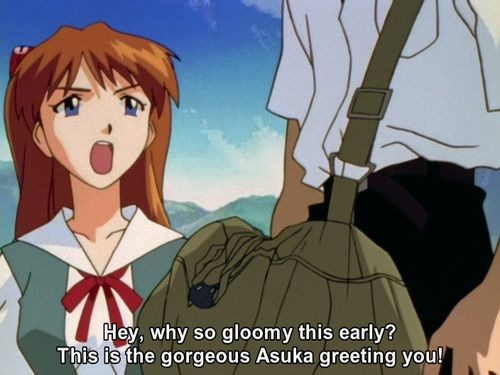
Afterwards, at the apartment, Asuka is apparently convinced that Shinji is about to be dunked into the trash. She barely gives him a second thought, instead remarking about how he’s going to be replaced. And, of course, because she doesn’t see him as worth her time.


We also take this opportunity to remind our viewers of the man about whom Asuka truly cares, being Kaji, complete with a small heart and all.
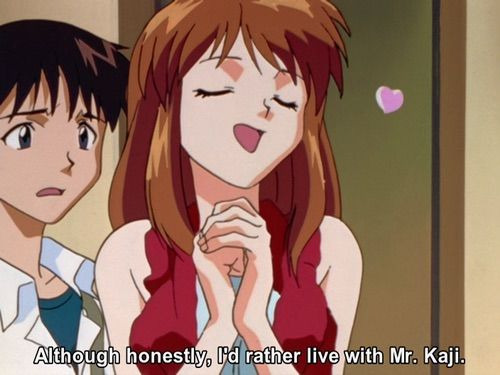
We also in this sequence see a rather interesting line from Asuka:

She remarks upon the fact that the Japanese do not have locks on their doors, and there’s really no way to barricade them, either. In essence, anyone can come and go through the doors as they please.
Now, think back to the Arael fight for a moment and to Asuka’s insistence that the angel not look deeper into her mind or dig deeper into her heart. Asuka only wants others to see the “outer shell,” the “gorgeous Asuka,” the perfect Asuka. Later on in this episode, Asuka complains about the fact that her Japanese debut made her appear “uncool.” She is obsessed with the idea of projecting only the best to others. Hence, the concept of simply allowing anyone inside frightens and irritates her. There’s no sense of privacy. While for the rest of her life in Germany, Asuka was able to keep her inner self locked away, in Japan, she will no longer be able to do so the same.
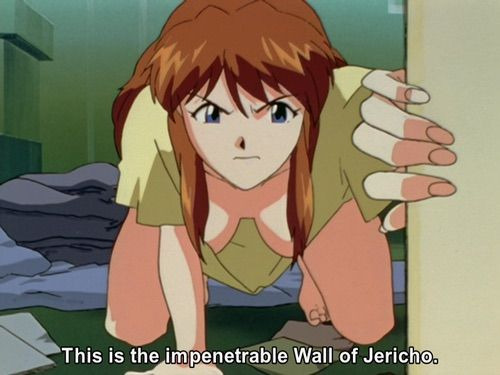
Oh, hey, remember what I was saying about Asuka having a fairly small breast size? Check out the screencap above. Compare it to the scene on the boat, and you’ll see what I mean.
Speaking of this sequence, Asuka is challenging Shinji, because, just like in Germany, she intends to validate herself through the use of local boys. Now that Misato has confirmed for Asuka that Shinji is not being replaced, Asuka is suddenly interested in him, since he’s a fellow EVA pilot and a saviour of humanity. His standing means something.
And so she offers the “challenge”. The Wall of Jericho, by the way, fell. She’s trying to get Shinji to want her, trying to get Shinji to desire her and give her attention so that she can laugh at him and ignore him, thus validating. Just like how Asuka’s initial response was to put him down, here Asuka attempts to create a relationship in which she is in the superior position via emotional weight.
When Shinji fails to respond, she decides to take matters a step further. She lies down next to him with her breasts in full view. He’ll have to reply to this. Not to mention the fact that she was having nightmares.
Either way, she falls asleep. Shinji panics, his gaze focused on her breasts (Shinji’s attraction to Asuka is almost entirely if not entirely sexual in nature, as we’ll see when we get to End of Evangelion and so forth), and he decides to take the bait, as Asuka thought he would. He prepares to kiss her, but in the quiet of the night, Asuka reveals the true self that she has never wanted to reveal:
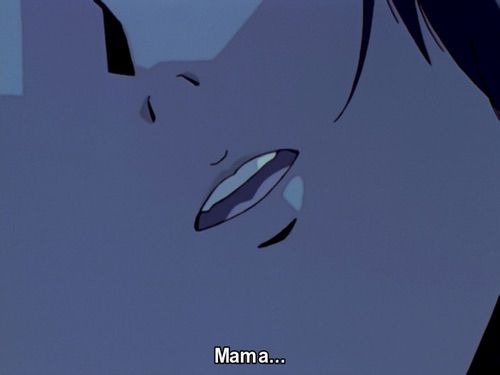

Even though Asuka wants nothing more than to become an adult, she’s still a child. She can’t wait to grow up (even in the screenshot above, you can clearly see her breasts), but she cannot escape the sheer levels of dependency and need for attention that her mother’s lack thereof left. Deep scars gouged into her psyche.
Her need for attention drives her for the next few episodes, too, as well as her need to absolutely be the best. In the ninth episode, she’s able to “synchronize” with Shinji, showcasing her capability to do so, and yet they still suffer the breakdown above (because you can be functional externally without being functional internally, like most of the adults on the show). In the tenth episode, she can’t stand the thought of Shinji not paying attention to her when he glances over at Rei in her swimsuit and so not only points out her breasts but also calls back to him to watch her jump. Later on, she would rather die in the volcano than fail the mission. In the subsequent episode, she gets even with Shinji by taking the hit, because she can’t stand the thought of not being number one, of not being the person upon whom people depend and to whom people give all of their attention (similarly, she takes charge of the group during the blackout), and so on.
And eventually we end up at the infamous asushin kiss, the kiss which many fans of asushin herald as a great proof of the canon nature of asushin. Let’s take a look, shall we?
In the beginning of the episode, Asuka tries to call Kaji again, this time pretending that she’s being sexually assaulted in an attempt to get him interested. If that’s not desperation on an incredible level, then I don’t know what is. Later, she goes on a date with a boy, but she apparently skips out on said date because she claims that he was boring (read: not as high in her internal standing as Shinji or the master of validation, Kaji).
Misato goes on a date with Kaji. Technically speaking, she has gone out with Kaji and Ritsuko, but Asuka clearly processes this as a date between Misato (whom she doesn’t entirely like) and Kaji. At this point, Asuka is clearly somewhat uncomfortable with these proceedings, because Misato, an adult is being validated, whereas Kaji has left Asuka in the dust.
At this point, Asuka turns to the other boy in her life whose body and validation are mostly immediately accessible to her: Shinji. She asks him what he thinks Misato and Kaji are doing, at which point he tries to get out of the conversation. Then she inquires whether or Shinji’s ever been kissed. He says that he hasn’t, and she pushes him. But take a look at her face: When she asks him, she doesn’t seem to be happy or even content, but rather melancholy, wishful. She’s thinking about Kaji and about validation.
Note: Asuka is also a teenage girl, and she’s probably not being so calculating here as the presentation of my analysis would appear. Part of this is just simple experimentation, and she is probably drawn to Shinji in the typical “allosexual boy and girl existing within an environment at their age” type of way. Nonetheless, let’s move beyond that and see the kiss within the framework of Asuka’s overall arc within Evangelion.

Shinji doesn't look too happy at the prospect of such a kiss.
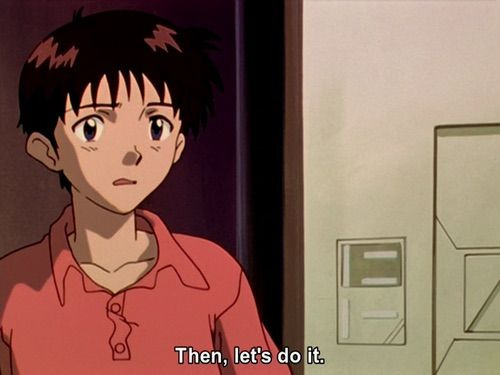

When he refuses, Asuka prods him. Asuka has become excellent, as I mentioned, at turning her hate of humanity into a weapon: She drives a stake into his heart, pointing out the death of his mother and asking him if he’s scared. At the defilement of his mother’s name, Shinji responds that of course he’s not scared of a little kiss, and Asuka stands up. Threateningly. She’s taller than him, and the shot of her coming towards him is framed in a manner that is more threatening and towering than romantic.

As Shinji and Asuka approach one another, Shinji takes on a faint blush (considering that he thinks Asuka hot, there’s little surprise here), while Asuka looks more serious than anything. She hesitates in kissing him and tells him to stop breathing. Him being human, apparently, distracts her on some level.

She then grabs his nose and kisses him suddenly. They stay that way for a while without moving, locked in a fairly awkward kiss.

Poor Shinji can’t breathe, and he begins to turn red, then blue, as Asuka literally suffocates him.
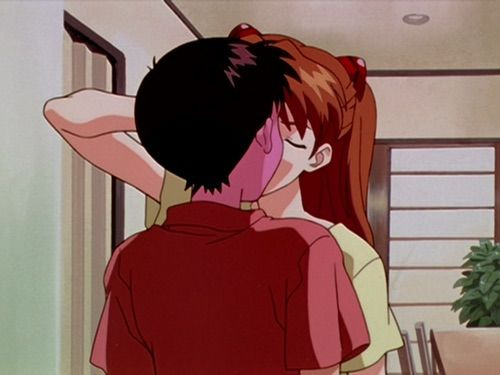

Now the first time that I saw this scene, I thought that this was a simple erection joke, with Shinji balling his hand into a fist in order to cover up the, ahem, tenting in his pants. And perhaps that was Shinji’s initial reaction (after all, he’s a fourteen-year-old boy and he’s kissing an exceedingly attractive young woman to whom he is obviously sexually attracted, whose breasts he has seen before, and to whom, as we later find out, he masturbates to). But as the kiss goes on without break:
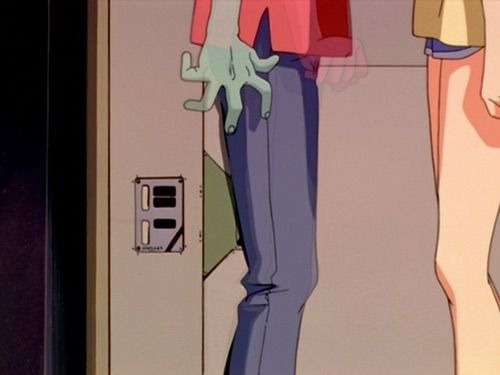
Poor Shinji literally begins to suffocate. He’s turning blue from an utter lack of breath. He’s not exactly having fun. Finally, unable to stand the rather deadly lack of breath, he pulls away from Asuka, gasping, and starts to pant heavily, relieved that he’s not actually going to die from asphyxiation.

To Asuka, however, this is more than a rejection. There are a lot of things happening in this scene: First of all, kissing the Third Children didn’t actually make Asuka feel better. Second of all, Shinji clearly had no idea what he was doing and was incapable of pressing forward with Asuka, instead standing there until he could no longer stand it and stumbling away. Hence, he’s not exactly a virile “player” like Kaji and is lower on the “validating” list for Asuka. Third of all, he didn’t continue and he actually left her, implicitly rejecting her. Fourth of all, no, he’s not Kaji. Picture this from Asuka’s perspective for a second: While the man of your dreams is on a date with a woman whom you don’t like very much, you kiss a boy, and you continue to kiss that boy while thinking to yourself, ‘Why don’t I feel happy yet? Why don’t I feel happy yet? How long do I have to wait to feel happy?’ Then the boy you’re kissing abruptly breaks away with you and starts gasping for breath, obviously relieved that he’s no longer kissing you.
It’s not like you were just rejected by Kaji. You were just rejected by the Third Child, a regular fourteen-year-old boy of the sort that you could get by the bushel in Germany and most of the least aggressive boys you’ve ever seen in your entire fucking life.
Asuka turns away and runs to the bathroom to gargle.

Asuka immediately tries to save face by pinning the blame on Shinji, because of course her upset-ness has nothing to do with the fact that she’s just suffered one of the worst rejections and least validating experiences in her life and everything to do with Shinji being a bad kisser (hint: it’s the other way around). Asuka’s not an adult. Asuka’s still a child, and when push comes to shove, she responds her own failings by blaming Shinji. When Shinji pointedly asks Asuka what’s wrong, Asuka shoves it back in his face and proclaims that she’s upset because she kissed him. Which is true, but not in the way that she means for Shinji to interpret events.
All of this, by the way, is framed within the context of Kaji and Misato reconnecting after a departure of eight years, a true kiss of love to contrast this muddled kiss of two teenagers failing to communicate.

Later on, Kaji arrives home at last, Misato in tow. Kaji puts Misato to bed, ensuring that she’ll be all right, and walks out. Asuka immediately jumps on the chance and seems to be in much better spirits after seeing her dear Kaji-san again.
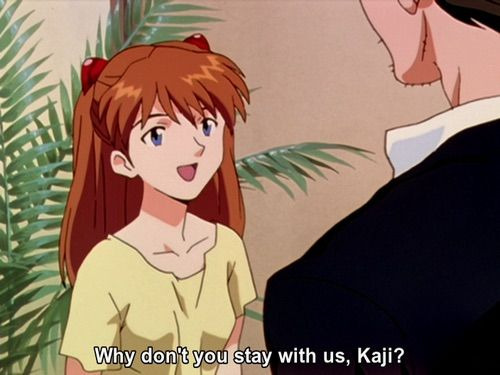
Kaji kindly declines the offer, pointing out that he needs to go home, and Asuka insists. Shinji might be useless trash, but surely Kaji will save the day.
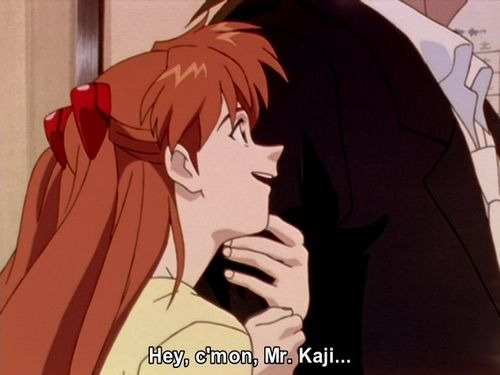
Unfortunately, while Asuka might be putting the uttermost “deredere” that she can around Kaji, he refuses and quits the apartment, leaving Asuka standing by herself. And notice how utterly heartbroken she is in the subsequent shot, while she makes an important observation:

This, the smell of lavender, of course, is a callback to an earlier part of the episode, right before Asuka’s date with Hikari’s friend, wherein Asuka asks Misato if she can use Misato’s perfume. The program going on in the background, by the way, is seemingly about a former couple arguing, with one of them declaring that (he) still loves (her) and the other one saying that it’s impossible, that (she) isn’t the person that (she) once was, and that it took (her) three years to forget (him). Of course, the immediate analysis is that this relates to Misato and Kaji’s relationship. But could it also refer, perhaps, to the fact that Asuka is trying desperately to become something she isn’t, e.g. the idea that people and time can’t turn back to what they once were?
At any rate, Asuka requests that she use Misato’s perfume, and Misato refuses her.

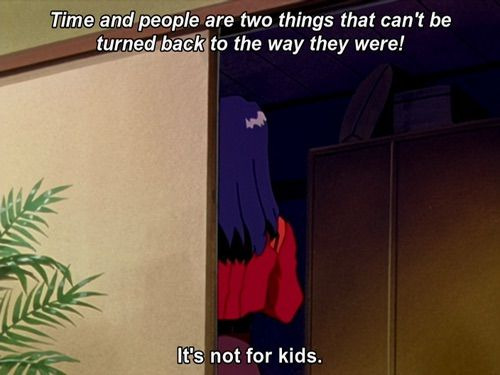
“It’s not for kids,” Misato says, implying blatantly that Asuka’s just a kid and that she’s an adult and hence can use the perfume. Naturally, Kaji validates Misato. Yes, Misato is an adult; yes, Misato is worthy of receiving Kaji’s love and attention.
Asuka isn’t.
Asuka’s a child, unworthy of the perfume and unworthy, it seems, of Kaji’s attention or affection. In later episodes, Asuka continues to try to draw Kaji’s attention, such as when she barges into his office only to find out that Toji has been selected as the Fourth Children, and when he shuts her down yet again.
Far from the romantic kiss that most fans of asushin seem to consider this occasion in EVA, the kiss is one of those moments wherein we’re reminded that Shinji and Asuka don’t understand one another. Shinji can’t think of why Asuka is upset. Asuka doesn’t care about Shinji and is only using him to validate herself, rather than out of any actual romantic reasoning beyond the sexual tension faced by allosexuals of their age.
(Now, I’m going to do a bit of a topic change so that I can talk about Rei and Misato, and how they relate to Asuka.)

In the beginning of episode nine, we see Asuka, as I mentioned earlier, considering herself to be the best of the best. She asks Shinji where the First Child is and proceeds to speak to the First Child.
When Asuka approaches Rei, her shadow covers the book that Rei is reading. The First Child responds by shifting the book, as if Asuka’s presence doesn’t bother Rei whatsoever and Rei couldn’t care less about Asuka. In other words, the opposite of the attention that Asuka seeks.
Now, a word on the framing of this scene. They’re outside, in public, surrounded by students. Asuka is extremely popular and a new student. Literally everyone is staring at Asuka and Rei when Asuka loudly declares herself to be the Unit 02 pilot. Now, notice that she specifically refers to Rei as the pilot of the prototype. Before Rei has even said a word, Asuka is immediately setting up the First Child to be inferior.

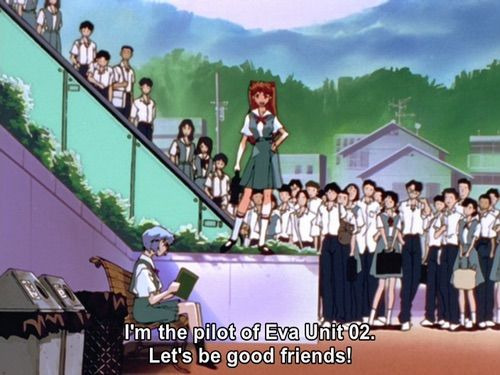
There are students everywhere. Asuka has put Rei, who clearly doesn’t care, on the spot. Rei, very rightfully, asks why.

Now, Asuka doesn’t reply that she wants to be friends with Rei, or that she finds Rei interesting, or, in reality, anything that one would normally say. No. Asuka responds:

'Because it’d be convenient, in lots of ways.’ Of course, Asuka is understandably simply being Asuka. Asuka doesn’t really know how to interact with other people except by establishing herself as dominant and very clearly and obviously setting up a one-way relationship in which they pay attention to her and she gives the appearance of not giving a shit about them. However, let’s give Asuka props for reaching out to Rei. Asuka doesn’t want to strike up a hatred of Rei, which is something that people tend to miss: Asuka doesn’t just walk around looking for conflict. She genuinely tried to become friends with Rei.
Unlike everyone else at the school, however, Rei doesn’t care for Asuka’s status. Rei doesn’t really care about anything at all.
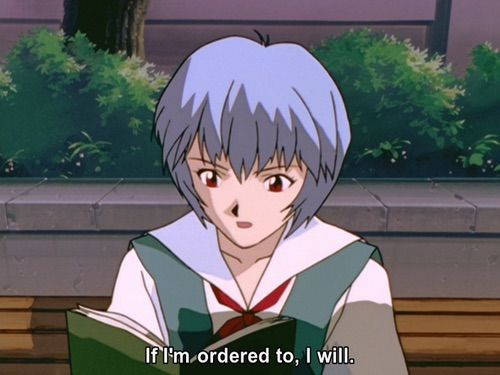
Asuka is pretty dumbfounded at this. 'If I’m ordered to, I will.’ Instead of trying desperately to become an adult as Asuka is doing, Rei is essentially akin to a robot from Asuka’s perspective, simply waiting for orders.
Asuka thereafter refers to Rei as a doll. As we know, Asuka hates dolls, because her mother spoke to a doll and because she agreed to take the doll’s place and kill herself with her mother as long as Kyouko didn’t stop being her mother. And so Asuka comes to associate Rei with everything that she hates: a doll only capable of listening to its master, utterly dependent upon its master for everything, completely unable to think for itself. Actually, the entire willing to die thing comes back to bite later, as we’ll see in the all-important elevator sequence.
At any rate, from this initial issue and fracture within their relationship, Asuka actually does try to reach out to Rei a few more times. For example, in the episode with Sahaquiel, Asuka is the one to drag Rei to dinner with herself, Shinji, and Misato; she even foregoes what she was originally planning in order to go to a place where Rei, a vegetarian, would be satisfied. Similarly, after the attack with Matarael, Asuka good-naturedly responds to Rei’s philosophizing, not even insulting or making fun of her for it, but responding in an Asuka-like way. And so forth.
Asuka does have her reasons to dislike Rei, however. For example, Asuka believes that Rei is the favorite, as she explains during the black-out, calling Rei a “wondergirl”. Rei, of course, replies that no, Rei isn’t the favorite; Rei knows that quite well. But from Asuka’s perspective, Rei is the favored pilot, which is partially why Asuka dislikes Rei, because Rei is essentially taking—from Asuka’s POV—the title of “best pilot.” Rei and Shinji actually. But we’ll get to that.
To some extent, Asuka also dislikes Rei because Asuka perceives Shinji as trying for the First Child even as he avoids her like the plague. While the love stuff / love triangle stuff doesn’t really affect Rei and Asuka’s relationship, it is important to warrant a mention: Kaji doesn’t validate her; Shinji only cares about her for her body (he also cares about her as a friend, but Asuka rarely sees that, and we’re looking at this from her perspective) but seemingly cares quite a bit about Rei. It’s a matter of validation, and it’s another reason that Asuka dislikes Rei.
Okay, so to recap: Rei is a doll; Rei has attracted the attention of a boy whose Asuka was unable to capture in a way that suits her; Rei is willing to die for others; and Rei is favored as a pilot above Asuka.
As we know, as the series progresses, Asuka slowly loses her synchronization rate while Shinji starts to catch up, culminating in “You are number one!” at the start of episode sixteen. Asuka places her entire worth upon being a pilot, because she has nothing else. Her mother died just as Asuka was selected to become a pilot. Asuka decided never to cry again and put forth her everything into being a pilot. She became the pilot of the first combat-ready unit and achieved the highest sync rate of all. She cares so much about piloting and about looking good while piloting that she wears, as I mentioned, the neural interface headset at all times, even in the shower.
And then Shinji takes over.
Now, for a bit of EVA science, I have to mention that the reasons behind the sync rate were partially her fault and partially not. On one hand, while Unit 00 and Unit 02 are based upon Adam and contain within them only partial souls, Unit 01 is based upon Lilith and contains within it a full soul. Naturally Shinji is going to outpace all of them. The other fact, which is “her fault” (insofar that it could be avoided) is a result of the whole validation / mental unraveling thing.
Asuka does not take well to Shinji becoming number one. Rei, however, doesn’t seem to care. This boils over in the infamous elevator scene. Asuka and Rei are going down for a while when Rei tries to speak to Asuka.
Rei explains that Asuka has to open her heart to EVA, to which Asuka responds very negatively, exclaiming that of course she opens her heart to EVA. This is untrue, of course: Asuka keeps her innermost thoughts and feelings locked away, even from her mother / the EVA (in fact, part of her entire breakthrough in End of Evangelion, as we’ll see later, is due to the fact that she finally revealed her innermost self during her actual suicide / subsequent desire to live and so on). Rei genuinely reaches out and Asuka rejects the First Child, illustrating both of their developments: how high Rei has come, and how low Asuka has fallen.
She singles out Shinji as the root cause of these issues, because she’s no longer number one. She always perceived Rei to be the favored child, and now Shinji is also the favored child by the numbers.

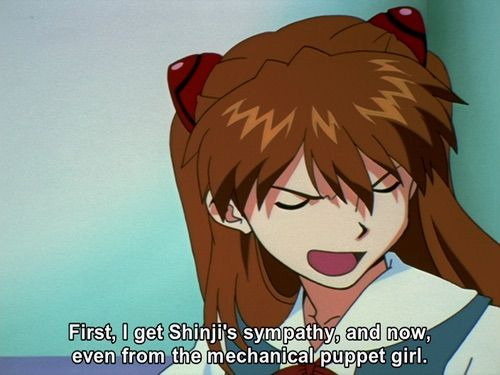

Asuka refers to Rei as a mechanical puppet (translated as a doll in other subs, to further the point), stressing the entire idea of how much she hates dolls. In fact, Asuka even compares herself to have “lost her edge” because of the fact that she’s sunk so low so as to be comparable to a puppet, to a doll.
Asuka doesn’t actually believe herself to be above Shinji and Rei. Asuka pretends that she does as a defense mechanism. Many on Tumblr could probably relate, the entire “yes I am perfect / yes I am garbage” thing. She pretends that she’s the best because it’s easier than actually accepting herself, and she seeks for others to support this. Unfortunately, the rest of the world seems to have a different belief, and as someone with HPD, Asuka cannot handle that.
When Rei continues to try to genuinely help her, Asuka desperately screams out:

She expects for Rei to assure her that of course not, of course the First Child is capable of making her own decisions and of course the First Child would not simply die if ordered to do so. And why? Because Asuka doesn’t want to believe that she actually could have died had her mother told her to do so. Since Commander Ikari is essentially Rei’s equivalent to a parent / guardian, it’s a direct comparison. To Asuka’s shocked horror, Rei admits that the First Child would die if ordered.
Asuka slaps Rei. Asuka is personally offended at Rei’s words, because the First Child’s decision preys upon her largest fear. Asuka is capable of committing suicide and as such she’s terrified of the thought of herself actually killing herself for any reason.
Rei confirms her fear. Rei confirms that an excellent pilot, loved by the world, at the top of the game, favored (from Asuka’s perspective), and even validated by Shinji, would still be willing to die if ordered. Like a puppet. Like a doll.

Later on, during her entire mind break with Arael, Rei saves her. Rei, the doll, the culmination of everything that Asuka fears, saves her. Asuka believed that she was an adult, believed that she could handle anything by herself, but at her lowest low, while all of her fears are dredged out by Arael, the mechanical puppet doll—the thing from which Asuka has been trying to escape forever—saves her.
In the end, Asuka isn’t independent. Asuka is dependent and unable to save herself. And Asuka, at the end of the day, is saved by the most (from her point of view) dependent doll of all.
It’s a slap in the face (sorry, babe). It’s a complete destruction of everything for which Asuka stands. Arael utterly destroys her and what saves her is the thing that she hates most.
But more on Arael later. First, it’s time to discuss her relationship with Misato.
I’ve already covered most of her relationship with Misato in sections above and in sections below, so consider this to be a quick recap: In essence, Misato represents what Asuka both wants and doesn’t want. Misato is a validated adult woman who has sex and wins the "Kaji Bowl". Asuka wants to be like Misato on the surface because she wants to be akin to Misato in terms of being an independent adult (she kisses Shinji partially because she believes, rightfully, that that’s what Kaji and Misato are doing on their date). And yet Asuka is disgusted by Misato; she’s disgusted when she asks if she’ll grow up to be like Misato, and she shames Misato for all of the sex. She doesn’t actually want to be Misato; she doesn’t actually, deep in her heart want to grow up.
(Back to validation / etc.)
Speaking of the Arael incident, now is an absolutely excellent to go ahead and recap everything that has happened thus far. Prior to the Arael sequence, we see Asuka trying to call Kaji yet again but being unable to do so, followed by her noticing that Shinji is talking to Rei. Note the yoking of Kaji and Shinji yet again: When her primary focus is unavailable (Kaji), she turns to the secondary substitute (Shinji) of validation. This time, she interprets him speaking to the First Children as herself having lost. She barely reacts to this. Having been pushed out of place in terms of both being the top EVA pilot and in terms of validation (she used to be with Kaji and her German boyfriends all of the time, but all of that has left her), she’s crumbling down.
At the beginning of episode twenty-two, known rightfully in the fandom as the “Asuka mindfuck” episode, Unit 01 has essentially been put into stasis due to the fact that she managed to consume Zeruel’s core, therefore making herself an actualised god. SEELE, which has no time or patience for Gendo’s shenanigans, places Unit 01 and Shinji on the bench. Asuka is sent out to investigate, confront, and defeat Arael. She knows what’s at stake in this encounter. She knows that, most likely, her reputation and status as being able to pilot at all rides on this. And hell, if she’s lost her status in terms of validation, then she can move past that and continue to ride on the waves of her being the best EVA pilot. She can climb back.
As a perfectionist (something also common to HPD), Asuka won’t allow herself to look bad.

However, Arael starts to probe deep into her mind. After the attacks of the other angels, Arael doesn’t seek to harm anyone (indeed, other than Asuka, they don’t actually hurt anyone else, and even in the case of Asuka, it’s less of a malicious attack and more of a child attempting to probe a small animal and not realising that a shovel is not the best tool with which to do so).
Misato orders for Asuka to retreat. But to Asuka, retreating from what she perceives to be her last chance at the spotlight is paramount to utter failure, to death. To walk away now, to run away now, will be to lose the attention forever.
She can’t have that. In a very Shinjiesque moment, she resolves not to run away.


When Arael continues to probe, we get the same thing that Asuka has always said: Asuka can’t stand others looking into her mind, her heart, her soul. Asuka very carefully cultivates this external image that is oh so easily broken to reveal the depressed, suicidal child within. Arael, who is capable of literally ripping out all of Asuka’s worst memories and repressed self, is Asuka’s worst nightmare, so of course this is the angel that unintentionally rips her from the inside out.
Actually, I’m going to take a random quick aside to say that the animations of characters in Evangelion putting their faces in their hands are some of my favorite of the series, if not anime in general, because the way that the hair bounces up and moves. I’d make some gifs, but just capping everything and writing analysis is taking enough. Back to the analysis.
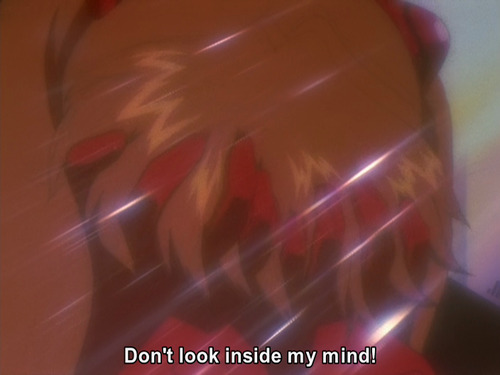

The worst part about all of this is that everyone else is hearing this. While we don’t know if the things that Asuka says in her mind to Arael are heard by the people in Central Dogma, it’s not impossible and is actually quite likely, what with the fact that she’s screaming all of her words with everything that she has.
Keep that in mind, given what we’re about to see her say. Picture her, after coming out of this nightmare, being fully aware that not only did she actually have a breakdown, but everyone heard her break down, audibly, crying and broken, and since saving the world is clearly a public event, something like this would likely be reported on the news as well to some extent (of course SEELE and NERV would massage the information, but the important part is that Asuka would think that it’s everywhere).
Arael starts out by reminding Asuka of her childhood: how her mother used to always work at Gehirn and never particularly had time for her daughter or her husband (which is a parallel between Asuka to Misato, as well as to Ritsuko, but I could write a completely another post about Asuka-Ritsuko parallels and the rejected love interest archetype that repeats itself again and again in Evangelion); how her mother finally became mother-like after being driven insane by only having a piece of her soul within her; how her father came to have an affair with her mother’s doctor and abandoned her mother; how her mother in turn abandoned her for a doll; how she agreed to die if it meant that her mother would not abandon her; how her mother actually committed suicide; how Asuka decided that she would never cry again (important). All of this, according to her, is something that she never wanted to think about again.
And of course not. She’s supposed to be the perfect one. She’s not supposed to have a backstory like this, not supposed to suffer and cry like this, not supposed to be this wounded attention-seeking child inside.
Most horrifyingly of all, the apparition of her mother-doll doesn’t recognize Asuka. In the ultimate blow to Asuka, who is so fiercely independent and craving of attention, the mother-doll asks who she is.
Because who is Asuka? The outer shell that she puts out (and that much of the fandom gobbles up), or the broken Asuka?
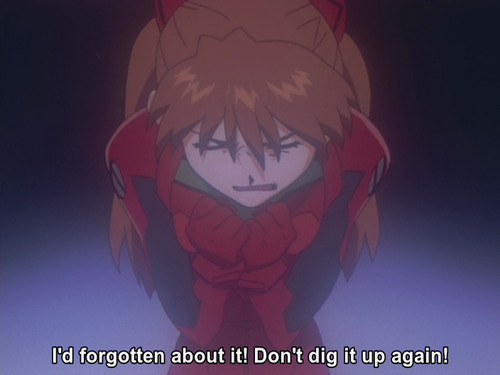
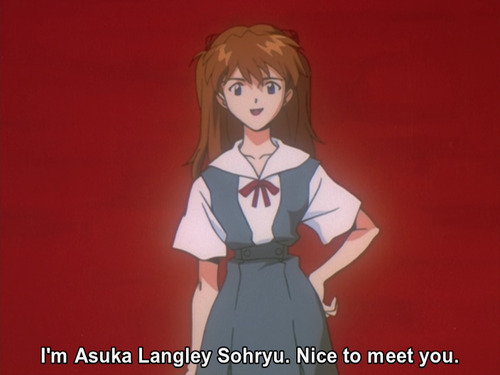



So we have an Asuka confidently introducing herself, complete with a little hair motion there to emphasize her beauty and to bring the attention to her with a large fanfare; an Asuka immediately putting others with her standard catchphrase of “あんたバカ?” / “anta baka?” because anyone who might possibly see through her must be placed in a subordinate position immediately, since Asuka has to be at the top, has to be the one to whom attention is given; an Asuka smugly talking about her “chance” to show off her piloting skills and hence gain attention; and, finally, that shot from the boat scene with Kaji. So look at me. That sexualised, sexualised shot that actually shows off just how young and unprepared she is.
Asuka claims that this isn’t the real her (which is true, because it isn’t the real her).

Immediately she’s dumped into a horrorscape wherein she seeks a figure whom she recognises as Kaji. She begs for Kaji (here, representative of all validating figures in general) to save her from this mindless crowd. She wants to stand out. She’s wearing her pilot outfit to emphasize her piloting skills as being a reason that she can rise out of the rabble. And yet that alone can’t bring her from the monotonous crowd that threatens to consume her: She begs for validation to save her, but it doesn’t, just like in real life.

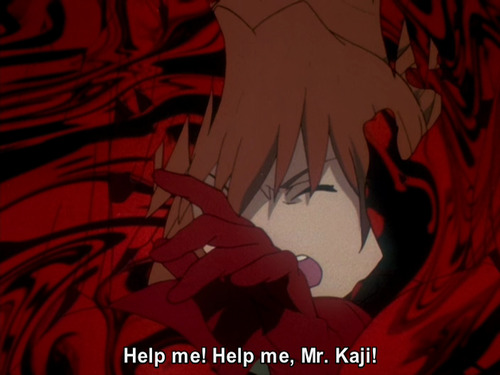
Now, quite a few fans (I’m looking at you, EvaGeeks) ascribe Asuka’s line asking what Shinji is doing in her nightmare to be with romantic intent (e.g. she’s thinking of him because she likes him romantically). But not quite. The shot below pans from Kaji to Shinji, because it’s not about Shinji but about yet again yoking Kaji to Shinji. She can’t have Kaji. She can’t even have Shinji, and Shinji is a memetically beta, passive boy with very feminine qualities.
Worse, Shinji has a very apathetic Rei-like expression here. He just doesn’t give a shit about this. And him not giving a shit about her is what breaks her. She needs attention. She needs someone to pay attention to her, because she relies on other people for her happiness.
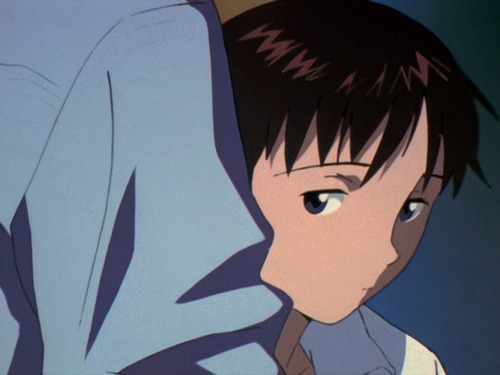
After this nightmare, we’re treated to the following shot of the true Asuka, usually the same line as from her earlier trying-to-be-an-adult look at me shot, but this time, as a crying child (and she told herself that she would never cry again, too):

The next shot is Asuka, naked, by herself, while Arael speaks to her, asking her if she’s lonely. Asuka, however, rejects Arael (whom she perceives to be her younger self). Basically, Asuka would be happier if Asuka accepted who she was and tried to build up based upon her own happiness rather than the false happiness from others (which ties into another Evangelion message concerning not relying upon false confidence, as Shinji does throughout the action arc only for everything to come crashing down on him during the incident with Leliel), but Asuka rejects that. Instead of admitting her weaknesses, Asuka repeats her maxims to herself, because they’re all that she has, even if they’re false and won’t make her happy (much like Shinji’s “I mustn’t run away”). All of this over Arael asking if Asuka ever loved (her mother).
Because if Asuka didn’t love herself, clearly she can’t love someone else, as she tells Shinji in End of Evangelion (by that point point, she’ll have figured out how to love herself, as we’ll see).

By the way, please note that the child Asuka’s hairclips are designed deliberately to evoke Unit 02’s four-eyed design, because Asuka isn’t merely rejecting her past self, but also her mother / Unit 02’s soul, which is why her synchronization plummets so intensely. In contrast, when Asuka accepts her failing and her mother as of End of Evangelion, she manages to sync well enough to go berserk, but we’ll get to that.
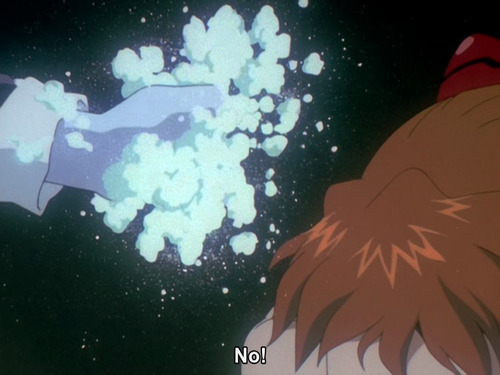



Of course, Arael, much like Leliel before them, isn’t having any of this shit.

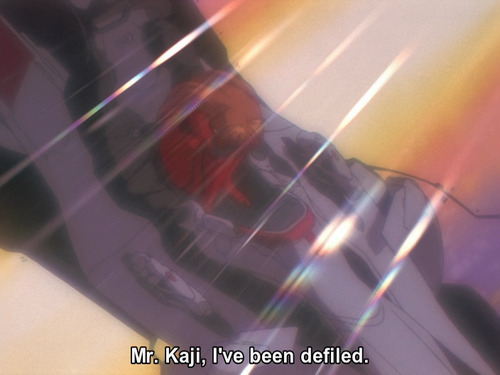

So Arael completely and utterly rips up Asuka while Rei destroys them using the Lance of Longinus, which results in Asuka lying there, shell-shocked, in the plug. She’s curled in on herself in fetal position (what with the womb symbolism of EVA and all) even while she tries to reject all of her mistakes thrown up in her face.
And at the end of it all, she calls out to Kaji. There’s a reason that fans refer to Arael’s actions as a “mind rape” (a term I personally hate): Asuka says that she’s been defiled. The presence of the angel having reminded her of all of her faults from which she can’t escape has defiled her. Moreover, she failed in her “final attempt” as a pilot. She’s done and she knows it. There’s nothing there left for her.
And worst yet, of course, is how she was saved. Just like in the elevator, what ultimately saves Asuka isn’t herself or her independence or even her skills at piloting, but the doll, the doll who would die if the parent analogue ordered death. Not only is Asuka herself fucked over, but the very ideals upon which she has built her entire world are fucked over.

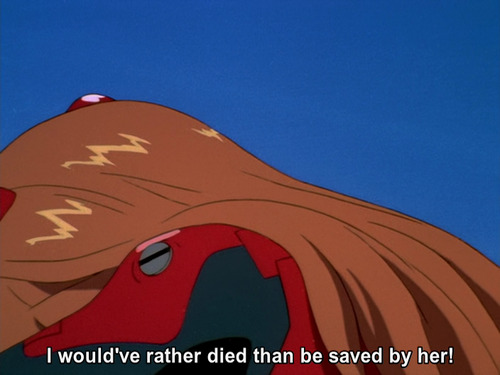

After this, Asuka is essentially finished. Shinji stands there, unable to do anything whatsoever. In the following episode, when Rei needs back-up, Asuka is completely unable to help her but simply sits there, entirely desynchronized from EVA. She’s useless. No one needs her whatsoever (except for the fact that they do; Shinji and Rei care about her as friends, and everyone else very much cares for her well-being, as we see in episode twenty-four and in End of Evangelion).
Following this, she apparently runs away and manages to do so without anyone interfering. Part of this is because Misato believes that Shinji and Asuka should be able to make their own decisions, which is an excellent parenting strategy except for the fact that she goes too far. Just as how Shinji ran off in the fourth episode only to be barely found by Kensuke and later by NERV agents, Asuka leaves, clearly with the intent of suicide.


Some people argue exactly how she intended to commit suicide. Some argue that she did so by slitting her wrists (hence her sitting in a bathtub), while others point out the fact that she clearly hasn’t been eaten for goodness knows how long, considering the clear shading at her cheeks, the prominent ribs, and the thigh gap that is far wider than even her typical skinny anime girl look. This scene isn’t fanservicey. It’s horrifying.
We also see her clothes neatly folded up next to her, which is something very common in suicide cases. She’s in the bathtub because a) that’s also a place associated with suicides and b) her entire “I hate everyone” scene (see below, just after this section) takes place, of course, with her standing over the bathtub. Throughout Evangelion, water comes up again and again, as a general aesthetic choice that encompasses life, happiness, escapism, thought, the inner world, all of that; here, Asuka is in an empty bathtub entirely dry, symbolizing the lack of life. In fact, the bathtub, and the entire house, is broken. Useless. No one would come to look at such a decrepit shack, which, of course, is the point.
Asuka doesn’t die, however. She survives because NERV agents find her, just as they did with Shinji. As we know, Asuka ends up in the hospital and is later placed in Unit 02. She’s surprised to find herself alive and so on and so forth. We’ll get to that in End of Evangelion.
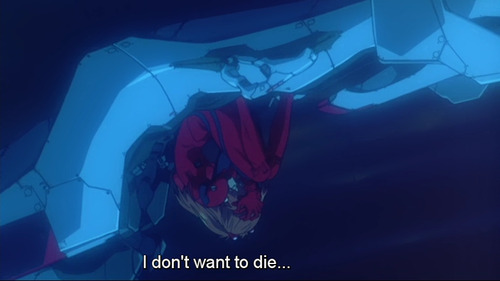
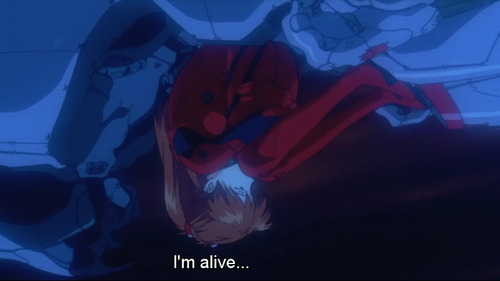
Asuka’s part during Instrumentality is pretty much review at this point, so I’ll just leave the screencaps here and allow you to draw upon what you’ve learned from the rest of this to drive home the points that I’ve been making all along.
You know, Asuka and Shinji aren’t that different at their cores (heheh). They both rely upon others for false happiness and end up getting smacked in the face for it until they learn to rely upon their own happiness, at which point they can begin to understand each other.


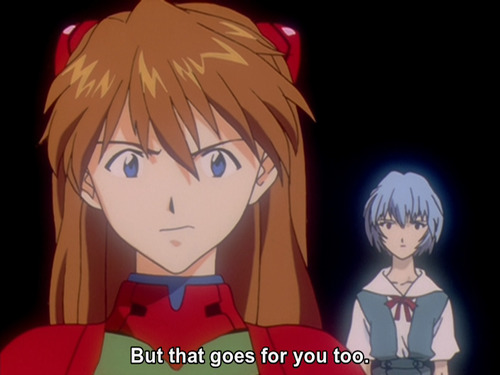
(Ahaha, the doll Rei telling her off again, because Rei understands her even if Asuka doesn’t want Rei to understand her. Check out that character development for Rei, by the way. The sheer amount of development from the Rei that we see in the first episode, incapable of even understanding the feelings that lurk within the soul, to the Rei we see here and in End of Evangelion, gently guiding Shinji and the rest of humanity through Instrumentality and rejection thereof.)




In the case of the Second Children, Instrumentality simply repeats what we already know what her in explicit detail for those who missed it.
Confounding all of this seeking of validation is the fact that Asuka, in reality, wants to be isolated. Underneath the HPD and underneath that flirty, lively personality with which she seeks attention, Asuka is hostile in a manner that keeps others away from her. When she’s alone, and sometimes when she’s particularly upset, she hates humanity and she’s cruel. I don’t mean cruel in the “anta baka?” sense, but in a sense that Asuka can transform her own hate for herself into a deep fuel with which to destroy others.
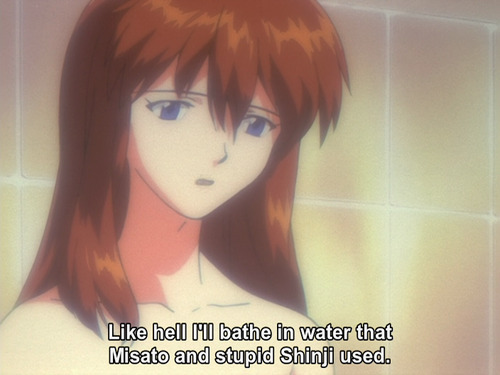
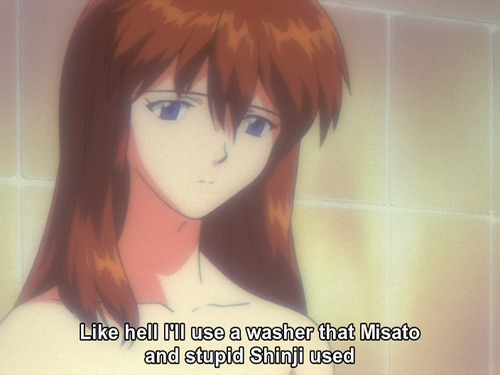

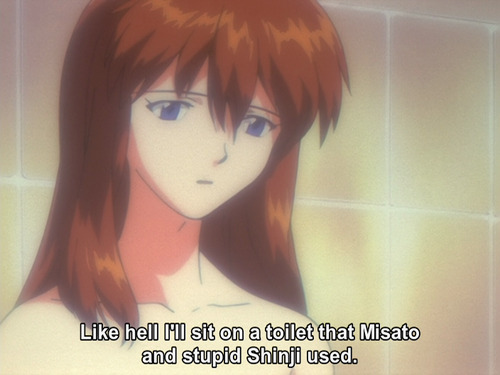




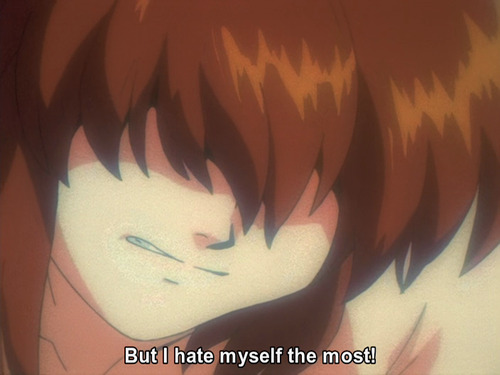
Here, she laments having to so much as interact with other human beings. She doesn’t want to use the same toilet or wash her underwear in with Misato and Shinji’s, wherein Misato and Shinji represent the people that inhabit the world around her. Interestingly, both the toilet and the underwear reference are very personal. Asuka has no issues “sharing” that flirty outer shell that she has created, but everything that lies within is hers and hers alone. Most of all, however, she hates herself.
In this sequence, and throughout this episode, Asuka complains about suffering from menstrual cramps. She mentions that she doesn’t want to be a mother (her dislike of being a mother and yet menstruating in contrast to Rei’s mother-like qualities and lack of menstruation is a topic worthy of its own post) and that most of all she hates herself, again. There are many reasons as to why Asuka would not want to be a mother. For instance, there’s the obvious fact that her mother committed suicide, which surely has left a sour taste in Asuka’s mouth (a taste, we find, that appears during the nightmare sequence with Arael). But there’s another aspect of motherhood: the idea of sharing your body and later your entire life with another human being. And that, I think, is the aspect of motherhood that terrifies Asuka most.
In End of Evangelion, Asuka is surprised to discover that she is alive when she awakens deep below the lake, uttering, “I’m … alive?”. As I mentioned earlier, Asuka killed herself because she did not believe that she held any worth to anyone. She talks about how no one will look at her now. Without the validation of others, she has nothing, and there is no purpose to anything. However, deep within the bowels of the EVA, Asuka finally synchronizes with the partial soul in Unit 02.

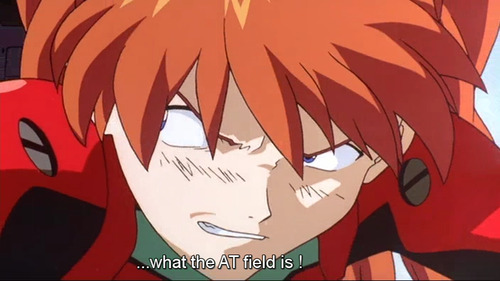
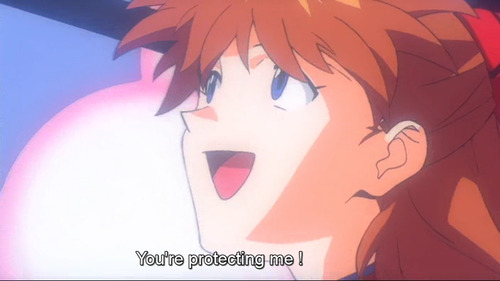
Here, she discovers two things: first, that her mother is always watching over her and protecting her and consequently will act as a constant “source of light” for the attention that she requires so desperately, and second, that the A.T. Field is in fact what separates the walls of human hearts. But instead of replying in a negative manner in the way that Kaworu did in episode twenty-four or in the way that Shinji did at first, Asuka is overjoyed at the news.
She has her A.T. Field. She has no need of anyone else, because she, her inner self, will always be protected by an impenetrable barrier. To Asuka, who represents the true extreme of human isolation (in sharp contrast to the true extreme of human union represented by Rei), the A.T. Field is more than a blessing. Instrumentality, by contrast, would be the greatest curse that Asuka could experience. Wielding this A.T. Field, Asuka is capable of destroying both SEELE’s forces and the EVA Series, until the S2 engines allow the MPEs to regenerate. And here the battle takes a turn for the worse, in the worst possible way.
As seen in the fight with Arael, Asuka associates both her success and her defeat in a sexual manner, specifically because she associates her subconscious sexually. Just as she commented that Arael’s exploration into her mind had resulted in her mind and herself being “defiled”, so too does her ultimate defeat in End of Evangelion feature heavy sexual symbolism.

Firstly, she is stabbed by the Lance of Longinus, in context symbolically transformed into a phallic weapon. The MPEs themselves, whose appearances are also quite phallic, produce anti-A.T. Fields which later aid in bringing about Instrumentality. They attack in unison rather than independently, and hence they represent everything that Asuka despises so much. All of them swarm her in a ritualistic (and here come the trigger warnings, guys) gang rape. They descend upon her, violate her, mutilate her, and leave. Notably, if one looks past the gore, one will observe that the damage done to Unit 02 almost makes the EVA appear pregnant, with the swollen at the stomach, or as if the EVA is in process of / has just given birth. There’s that fear of pregnancy, rearing its ugly head.

This is only exacerbated by the shot of Asuka screaming and grabbing her abdomen.

Naturally, it’s merely an injury. But the styling of the injury looks very much like that whole pregnancy thing. The EVA Series, representative of all which Asuka despises, has assaulted her and rid her of the very isolation that she so craves. When she manages to reactivate the EVA, going berserk for the first time in the series, the MPEs respond by piercing her with multiple phallic weapons, leaving her not quite crucified so much as stabbed, dominated, conquered repeatedly. Not in the relatively clean crucifixion, but as messy and horrible as possible.
Why, then, do the MPE cause her such an ultimate humiliation? Because even though she has identified with her happiness in human isolation and her happiness with her A.T. Field, she did so within Unit 02. Part of Evangelion is the rejection of the mother and of the womb-like plug and of standing by herself (because from within the womb, we can filter reality in a manner that causes the Hedgehog’s Dilemma). Hence, the narrative punishes Asuka for going about human isolation in the “wrong manner”. When she rematerialises herself in the last moments of End of Evangelion, she is doing so without EVA, the EVA having been destroyed. Shinji chokes her because Asuka cannot escape human contact. As part of the resolution of the Hedgehog’s Dilemma, Asuka must understand that she ultimately must interact with humanity, but she also now understands, loves, and accepts herself.
At this point, presumably a quantum Rei appears to collect Asuka’s soul. We don’t see her again until the pre-Instrumentality sequence. Just as a random aside, but I’d like to take the opportunity to point out that the Adam-Lilith complex, who appears as the person with whom the soul-to-be-harvested wishes to become one, took on Kaworu’s appearance for Shinji, not Asuka’s. Anyway: we next see Asuka while she and Shinji are “attempting” to communicate.
While Instrumentality is in its opening stages, we have this wonderful sequence of shots between Shinji and Asuka, with Shinji painted in the blue traditionally associated with masculinity and boyhood and Asuka painted in the pink traditionally associated with femininity and girlhood, neither of which particularly suits either one. While Asuka yells at him for not understanding her (and very rightfully calls him out), we’re treated to a series of flashes of Shinji’s eyes, sad and drooping, coupled with obviously objectified shots of Asuka.
Shinji doesn’t care about Asuka at this point except for her body (note that these shots don’t contain her face; of course Shinji does care about Asuka as a friend, but in terms of their strict ego-to-ego communication to one another, here’s what we get):


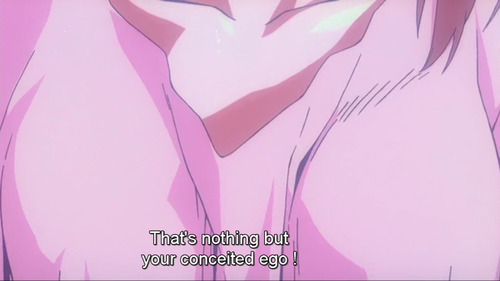


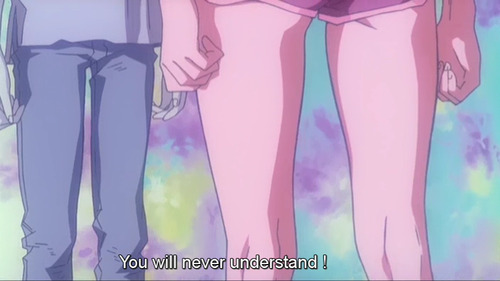
While Shinji gives himself half-defenses, Asuka points out that he literally just used her for her body. He can’t handle the actual living, breathing Asuka and so focuses on a projection of her made inside of his mind, a projection that would lie there two-dimensionally while she does nothing at all. [Anno looks directly at the camera like in The Office]


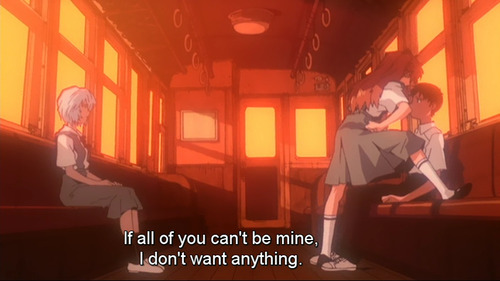
This climaxes with Asuka thrusting her chest into Shinji’s face (note the lack of her face in the first shot, cutting off her individuality and will in favor of simply offering her body, which could be any body at all, to Shinji) on the Hell Train.
She has realised that validation renders her, like Misato, as simply a body, when what she wanted to be validated as an individual. Now that she loves herself (regarding the entire “accepting her mother and isolation” bit above), she can validate herself and doesn’t need anyone else (hence, human isolation), but she also understands what Shinji is feeling.
We see Asuka next in the Hell Kitchen. Now, the Hell Kitchen is Asuka’s equivalent to Shinji’s Hell Train, which we just witnessed about.
The Hell Train is where we meet Shinji multiple times as he struggles with his mental thoughts and feelings. The train, because on a train one is surrounded by people yet constantly alone (just think about that shot from one of the initial episodes, wherein we see Shinji listening to his music on a steadily emptying train) and because, while a train ostensibly has a destination, one can technically remain on a train forever, being merely moved from place to place to some destination without exerting any force of one’s own. In this manner, the Hell Train represents both Shinji’s inherent issues (his avoidant personality disorder, the hedgehog’s dilemma, and the idea of drifting through life without purpose) and his current state.
Asuka’s hell is the Hell Kitchen. First of all, it’s Misato’s kitchen. Asuka wants nothing more than to grow up and become independent already, and yet there she is, sitting in the kitchen of the guardian upon whom she is dependent. Second of all, it’s a kitchen. The kitchen is the heart of the home, heavily associated with dependency and, dare I say, motherhood. Yeah. It’s definitely Asuka’s hell, and yet one from which she isn’t entirely able to escape.
There are also two vital aspects of this scene that deserve. The first one is pretty obvious and most people have noticed it: Asuka and Shinji are wearing the same outfits that they wore during the kiss sequence described earlier, a major aspect of a case in which Asuka was not validated. The second one is less obvious: The seemingly random broken coffee pot that spills across the floor is actually symbolism lifted from the scene in which Shinji informs Asuka that her beloved Kaji is dead, another major aspect of lack of validation. To recap: the symbols in the Hell Kitchen remind Asuka not only of her consistent inability to actually become independent but only of her failures in validation as a sexual adult.
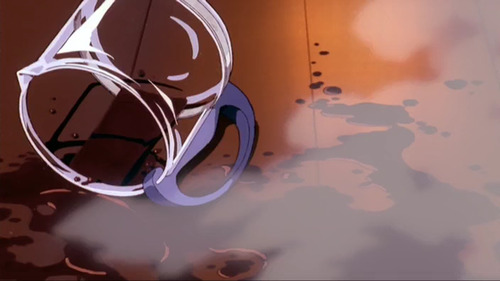
(Above is coffee cup during Instrumentality [rewatch the scene if you don’t believe me]. Below is the coffee cup from the Kaji’s death revelation scene.)

Asuka exists in this pre-Instrumentality state completely isolated. Here, she’s happy. There’s no one. She’s by herself and she can’t imagine a better existence. Then Shinji pops up out of nowhere (note that this is prior to full Instrumentality. In episodes twenty-five and twenty-six, we see the slow progression of Instrumentality, and they mention that Instrumentality had been ongoing for months if not years, as people’s egos interacted and slowly stripped down to the very essences of their beings). He runs over to Asuka and offers to stay with her forever, offering her his help.

Too little, too late.
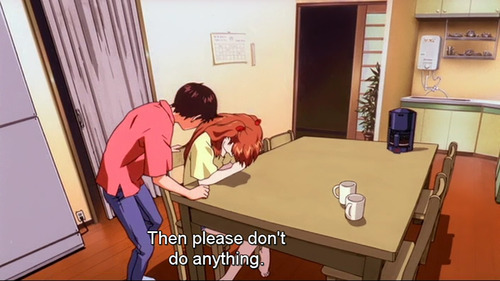

While Asuka sought validation in the past, after her experiences with the A.T. Field, she no longer has any need whatsoever of Shinji’s validation. Hence, she tells Shinji to leave her alone. After this, all Shinji says is “Help me,” because even his initial offering of assistance to her solely hurt her, and In reality, he was being selfish and merely attempting to get her to help him. He wasn’t there for her when Asuka needed him.


As Asuka points out, Shinji doesn’t need her. Shinji just needs someone. And Asuka doesn’t simply want to be someone; Asuka wants to be, well, herself, specifically. She wants to be valued for who she is, not because circumstances left her the least of all evils, especially for Shinji, whose first choice, per Instrumentality, was Kaworu anyway.


Asuka calls him out on his bullshit. Asuka points out that he doesn’t love himself, because she’s been there. She hated herself, but through the understanding of her mother and her A.T. Field, she’s okay. But she is rejecting his presence. She is rejecting him entering her mind, because she wants to be by herself. She wants to be isolated.
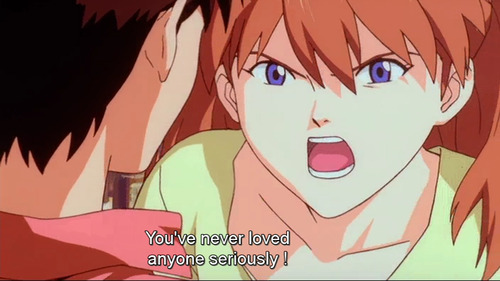
He continues to ask for help. She refuses. I’m going to interject right here one second and say that Shinji repeatedly, brokenly, whispering and then yelling, “助けて” / “Tasukete,” while Asuka calls him out (the framing of the scene would make it appear at first that Shinji is the protagonist and Asuka is the antagonist, but if you pay attention to the words and emotions, it’s the opposite). Instrumentality is her worst nightmare: As the literal symbol of human isolation, she can’t take the intrusion.

And so, in the act of causing Instrumentality to occur (by becoming one with Kaworu), Shinji chokes her. Shinji murders her in the process of Instrumentality because Asuka cannot stand the thought of being erased, of being one of many. And yet Asuka merely stares at him, apathetically, as if she could not care less about the proceedings if she tried. Shinji is killing her, and she still doesn’t give a fuck about him now that she no longer needs him to validate herself. (The opening ceremonies of the Komm, susser Tod sequence relate this is to Akagi Naoko choking Rei I.)

I’m going to point out one thing before we move on: this shot.
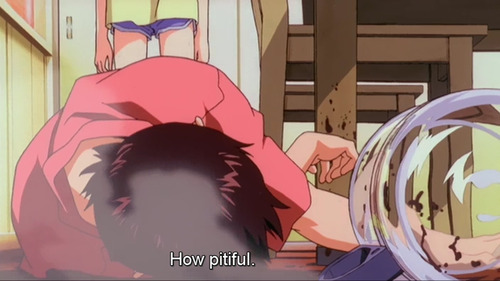
In this shot we see two very important things: Shinji on the ground and the coffee cup on the ground. Shinji and Kaji. The two men from whom she attempted to receive validation. And she says, “How pitiful,” not at them so much as at herself for needing validation from them. She’s moved beyond that now.
Instrumentality goes on. I’m not going to talk about the original drafted version of the live action sequences, because they were excluded from the final product and I don’t find them worthy of being analysed myself. Typically, when I analyse extraneous material, it’s because the material was cut due to censorship. In this case, however, there didn’t appear to be any censorship involved. So, I’ll just jump right in to what’s probably the single largest misconception about End of Evangelion.
The ending is 100% optimistic hopeful happy, even happier than EoTV / the original anime ending.
No, really.
Rei and Kaworu explain to Shinji, and the audience, that every single being that has the will to come back, will come back.
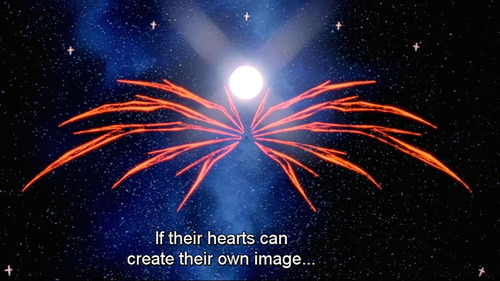



(Holy shit, just look at those visuals. [wipes brow])
Contrary to the (asushin-friendly) interpretation of the “new Adam and Eve”, Asuka and Shinji will not be stranded together on the beach forever. Rather, every lifeform that wishes to come back from the LCL can come back. Poignantly, we hear Yui’s often-repeated quote again:
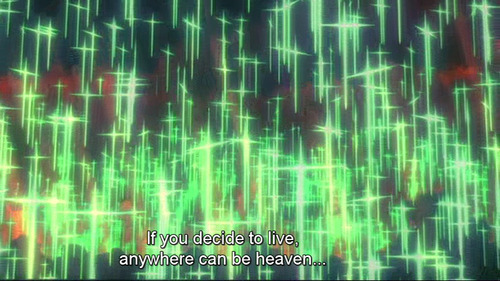
That’s the message of Neon Genesis Evangelion, gentlefolks: Even if you’re at the very brink of suicide, even if you’re at the very brink of escapism, as long as you have a will to live, you can return. What does that mean for Asuka?
Shinji’s the first back simply because he was in control of Instrumentality, thanks to both Rei and Kaworu (and Yui) deciding to place the future of the world into the hands of a depressed, avoidant, suicidal fourteen-year-old child who was capable, deep within his heart, of choosing to life. And the very second one back is Asuka, because, again, Asuka represents ultimate human isolation. Asuka represents the strongest will to live out of anyone. Asuka is driven to suicide when the external validation she had set up fails around her. But then she sets up her own internal ones. And now, now, she is the girl who screams, “I don’t want to die,” the girl who declares to her enemies that she’ll kill them all, the girl who reaches for the sun and is laid low by powers outside of her control.

But LCL? Perfectly within her control. And thus she exits first, exhausted from the process of having to reform herself, akin to Shinji in episode twenty. Shinji notices her. Between the quantum Rei sent out at the instant of the Third Impact and the sudden appearance of Asuka, Shinji is terrified for a moment that he somehow is still in Instrumentality. Hence, he chokes her.
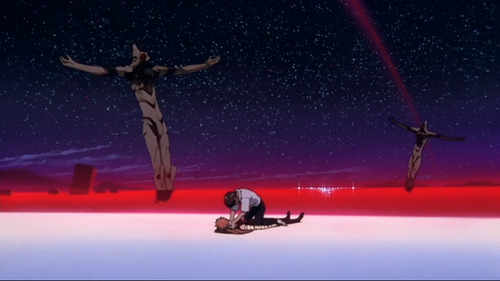
(*Disclaimer: I need to say, right now and right here, that I am not defending this nor the earlier choking of Asuka. Shinji is violent and misogynistic, and what he did was completely wrong. Which is part of the reason that the thought of Shinji anywhere near Asuka romantically causes my hackles to rise, because they harm one another on so many levels.)
If Instrumentality is truly over, then Asuka should be able to feel pain. And she does. After apathetically staring at Shinji for a few seconds, Asuka touches his face, indicating that she now understands his pain and that she can feel her own, confirming that Instrumentality happened but is over. Shinji stops choking her, but observe his fingers jittering over her throat here. If you watch the actual film, you’ll notice that there’s an extended shot of his fingers shivering as he decides whether or not to continue strangling her.

Interestingly enough, in this final shot, we see Shinji straddling Asuka in a manner akin to a (cis) woman straddling a (cis) man lying down. In fact, they’re much exactly mirroring the Shinji-Rei allegorical sex scene from just a few moments prior. Gender roles swapping, morphing. Becoming more attuned to their actual selves.
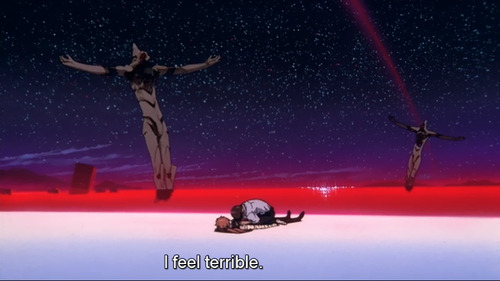
He breaks down crying, partially out of relief that he has rejected Instrumentality and that he is again alive, and partially out of disgust at himself. Likewise, Asuka says her famous line, “気持悪い“ / “Kimochi warui,” which can be translated as “How disgusting,” or “I feel sick.” What’s interesting here is that depending upon the translation, Asuka might actually be referring to herself, or to Shinji, or to both of them. I’m inclined to take on a more general interpretation. Asuka has this sick feeling because she has just crawled up onto the shore, reforming herself entirely via her mind from the LCL, only to find none other than Shinji with her once more. But she’s also saying it in regard to the pathetic state of humanity: herself, injured, having failed; Shinji, sobbing over her. And so on. A disgusting feeling, in general, at the proliferation of life once again.
Because that’s something else about Evangelion. Anywhere can be heaven, but not necessarily so. Still, I would argue that this is the most uplifting of all endings, because life will return to normal, and this time, Shinji and the others will be far better equipped to pursue their happiness.
If you have any questions, comments, or dissents, please message me! This was all basically a very bang and rush job, so I’m certain that it’s not perfect, and English isn’t my first language. Still, if you managed to read all of that, Congratulations!
#neon genesis evangelion#nge#asuka langley sohryu#evangelion#nge meta#asuka meta#tw: pregnancy#tw: gore#tw: suicide#tw: menstruation#tw: rape#i formatted it a bit for readability just to be transparent lol#nge spoilers#anti asushin#long post
1K notes
·
View notes